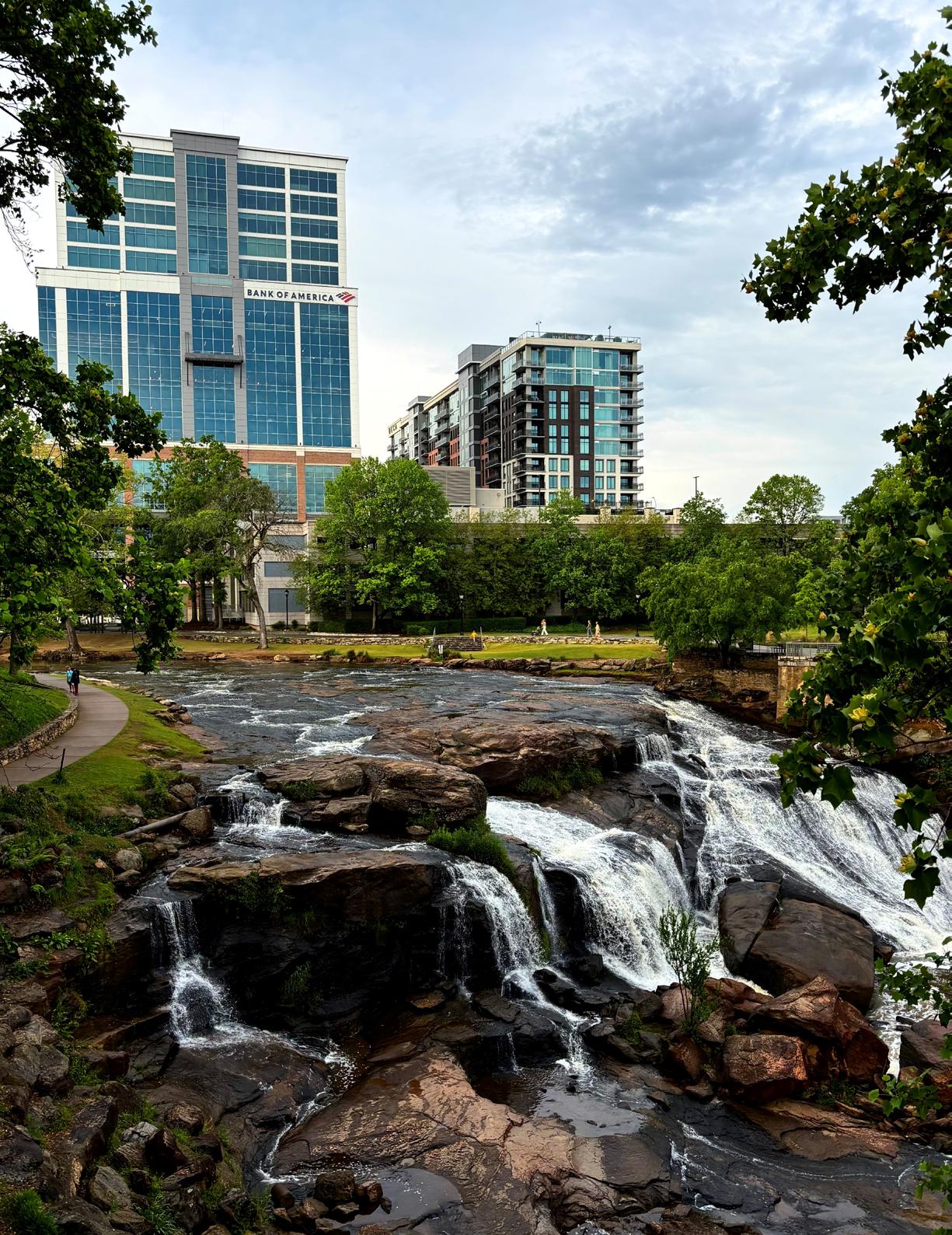

AIA College of Fellows
Founded in 1952, the College of Fellows is composed of members of the Institute who are elevated to Fellowship by a jury of their peers. Fellowship is one of the highest honors the AIA can bestow upon a member. Elevation to Fellowship not only recognizes the achievement of the architect as an individual, but also elevates before the public and the profession those architects who have made significant contributions to architecture and to society.
Muza Conforti.
In this Issue | Q2 2025
Remembering Chancellor Raymond G. 'Skipper' Post, Jr. FAIA
AIA25 - A Fellows Guide
Chancellors Cup Tournament Updates
2025 College of Fellows Component Grant Recipients
AIA Governance Task Force Updates
2024 COF Component Grant Recipient: AIA Triangle: Mini MBA Series
Interview with Graciela Carrillo, FAIA 2025 Fellow - Object 3 Led the Institute
Call for 2025 Latrobe Research Prize
Creating Learning Environments that Inspire & Engage Students: Editorial by Julia Hawkinson, FAIA
The Fellows Collection
Call for COF Executive Committee: 2026-2027 Secretary
What Does Your 'F' Stand For? Editorial by Rich Von Luhrte, FAIA
2024 COF Component Grant Recipient: AIA Arizona: Alleviating Phoenix’s Affordable Housing Crisis through Collaboration, Mentorship, and Competition
Regional Representative's Message
Interviewing an Icon: Two hours with Denise Scott Brown, Hon. FAIA.
AIA's New Global Campus for Architecture & Design: Construction Progress Update and Sustainability Initiatives
Remembered
Vice Chancellor Bursar
Secretary
Kate Schwennsen, FAIA
Jeanne Jackson, FAIA
William Hercules, FAIA
Steven Spurlock, FAIA
Editor-In-Chief
Associate Editor
Chair, Regional Representatives
Executive Director, College of Fellows
Jessica O'Donnell, AIA
Beresford Pratt, AIA
Stuart Pettitt, FAIA
Muza Conforti
COF RESOURCE GUIDE

COLLEGE OF FELLOWS NEWSLETTER

COLLEGE OF FELLOWS COMPONENT OPPORTUNITY GRANT APPLICATION

COLLEGE OF FELLOWS REGIONAL REPRESENTATIVE
WELCOME PACKET COLLEGE OF FELLOWS FORMER CHANCELLORS

DIRECTORY YAF CONNECTION ARCHIVE
Message from the Chancellor
By Kate Schwennsen, FAIA
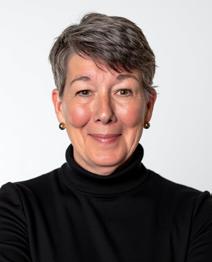
Iam writing this message upon my return from the Spring Meeting of the College of Fellows Executive Committee. Looking at my long “to-do” list coming out of that meeting I am pleased with the work and engagement of the College, and the work and engagement of Fellows across the Institute. This Chancellor’s message will recap the Spring meeting, informing you of our focus thus far in 2025 and the ongoing items on our “to-do” list.
We met in downtown Greenville, SC, a charming historic Southern city. The city’s promotional material truthfully states: “This thriving, dynamic place has gracefully transitioned from one of the Southeast's best-kept secrets to one of its hottest destinations.” I lived close to Greenville in Clemson, SC for over a dozen years, and knew the Executive Committee would enjoy a visit. With waterfalls and beautiful parks in the middle of downtown’s pedestrian filled tree-lined streets; A bustling economy (it has the most Foreign Direct Investment per capita in the U.S. with more than 250 international firms from 28 different countries); Vibrant arts and foodie cultures; And an active architectural community, Greenville is well worth a visit. We held our meetings at local offices, one day at LS3P and the other at Craig Gaulden Davis PBK. As is our custom we had a reception with local Fellows. Ben Rook, FAIA, generously volunteered to host the reception at his lovely home. We
sincerely thank all these Upstate architects for their gracious Southern hospitality.

Above from left to right: Secretary Spurlock, FAIA, Brusar Hercules, FAIA, Chancellor Schwennsen, FAIA, Vice-Chancellor Jackson, and COF Executive Director Muza Conforti.
We started our meetings with reports from the members of the Executive Committee. My report included invited conversations I’ve had with AIA leadership about various initiatives, including the Governance Task Force, jury-recommended changes to the Jury of Fellows, and the EVP-CEO search process. The report of the Vice-Chancellor, Jeanne Jackson, FAIA, included a Zoom call-in from the Chair of the Regional Representatives, Stu Pettitt, FAIA, sharing news from the Regional Representatives, the College’s important boots on the ground. The May 1st launch of the new AIA.org volunteer site will include any open opportunities for members to participate in these roles.
The report of the Secretary, Steven Spurlock, FAIA, included a Zoom call-in with Jessica O’Donnell, AIA, editor of The Quarterly, (and Strategic Council Moderator). She provided metrics on the readership of The Quarterly and the College’s LinkedIn page. We advanced planning for this current issue, the third quarter issue in which we want to feature mentorship programs from the regions, and a late-fall special issue retrospective of the Latrobe Prize. Steven provided an update on our revised “Pathway to Fellowship” AIAU course, delivered April 30th and thereafter made available to Fellows, Regional


Reps, and chapters for their use. He also reported on the work of the AIA Awards Task Force, of which he is a member.
The report of the Bursar, Bill Hercules, FAIA, updated us on the activities of the Young Architects Forum, (Bill is our liaison); and reported on the short- and long-term performance of the College of Fellows Fund. We take our fiduciary responsibilities of this fund very seriously, so not surprisingly we spend time on this subject at each meeting. The report of the Executive Director, Muza Conforti, included the great news that the recent call for the 2025 Latrobe Prize is resulting in much interest. Proposals are due June 30th via the AIA platform https://aia.secure-platform.com/a/solicitations/408/home More information about the Latrobe Prize can also be found later in this issue. Preparations for AIA’25 in Boston made for an important discussion. Readers can find “A Fellows Guide” to the conference in this issue. We hope to see many of you at our various events. To assist new Fellows with preparations the Executive Committee is planning a “Know Before You Go” Zoom, which was also discussed.
We then spent some energy on deeper conversations about the COF Fund and its financial management, led by the Bursar; the College’s outdated Bylaws and the processes for their revision, led by the Vice-Chancellor; the Standard Operating Procedures of the College; the ExComm’s progress on 2025 goals; the relationship of the College and the AIA; and various awards processes. We concluded the meeting
Photo Above Courtesy of Muza Conforti: Wall architecture at the office of Craig Gaulden Davis PBK.
Photo Above Courtesy of Muza Conforti. Sculpture at the home of Ben Rook, FAIA.
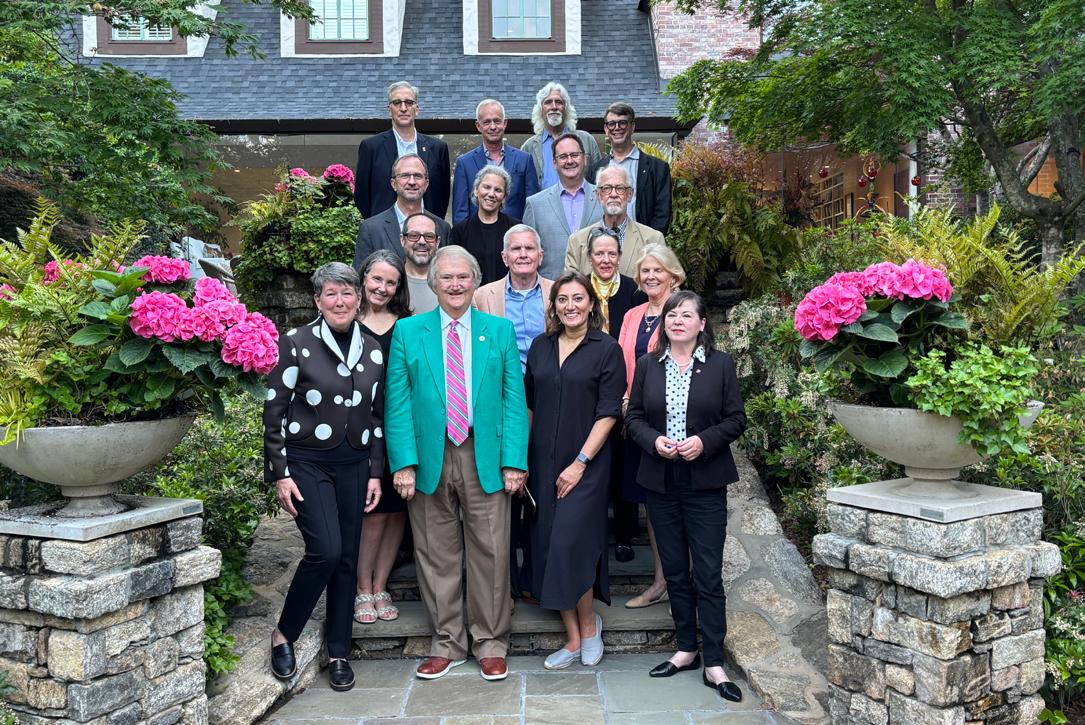
with a Zoom call with Former Chancellors. It was a contentfilled meeting.
In closing I’ll return briefly to the Greenville Fellows reception, where I visited with some dear friends. One of these is Jim Barker, FAIA, who was the President of Clemson University when I joined the university as the Chair of the School of Architecture. Having this accomplished architect as the university president, (one of only 2 in the country at the time, and now I think there are none), was one of the things that attracted me to Clemson. He stepped down from the role of President in 2013 after 14 years in the role, and he came back to the Architecture classroom. What a privilege for students to learn from this leader!
Jim taught a sophomore studio and workshops on watercolor, but the contribution that only he could make was an elective seminar, “The Architecture of Leadership”. Jim modestly described the course, “It’s how leadership is built and relates to architecture. What’s the foundation? What’s the equivalent of a column? We use case studies from my time in the president’s
office. My department chair suggested I teach that. If I didn’t, what would happen to the knowledge I’d gained, if it wasn’t transmitted to students? It sounded like a good idea.” It was a good idea, but the depth and thoughtfulness with which he delivered and developed this course made it a great idea. Students were inspired by this course, engaged in learning about leadership from a true leader. Following Jim's lead, I encourage every Fellow to share your unique knowledge, to inspire and engage as only you can do.
Photo Above Courtesy of Muza Conforti. Reception with local Fellows at the home of Ben Rook, FAIA.
Kate Schwennsen, FAIA 63rd Chancellor
AIA College of Fellows

Announcements
The American Institute of Architects College of Fellows Path to Fellowship 2019
MENTORSHIP HIGHLIGHTS
The Indiana Chapter had Breakfast with the Fellows on March 27, offering a time for fellowship and mentoring with emerging professionals.


RESEARCH UPDATES
Join Jean Carroon, FAIA at AIA25 for her session alongside Diantha Korzun, AIA, and Alyssa Murphy, AIA as they help architects navigate effective design desisions that decrease water stress and support a healtheier, more equitable world.
Research & Materials Track at AIA25. Session title: 'Water & Equity: Driving Local & Global Health Through Design' (registration required)
WAYS TO ENGAGE
The College of Fellows is seeking nominations for the position of Secretary. The Secretary serves a two-year term, 20262027, and is one of four members of the Executive Committee governing the College of Fellows, along with the Chancellor, Vice Chancellor, and Bursar.
See the full Call on page 36 in this issue. Application deadline is 5pm ET, August 14, 2025.
FELLOW SPOTLIGHTS
Join Lynn Craig, FAIA and Terry Walker, FAIA at AIA25 for urban sketching alongside Jon Thompson, AIA, Michael Janaskie, AIA and Cleve Walker.
Design Excellence Track at AIA25. Session title: 'Urban Sketching in the South Boston Seaport Area' Staurday, 6/7 from 10:30am-1:30pm (registration requitred)
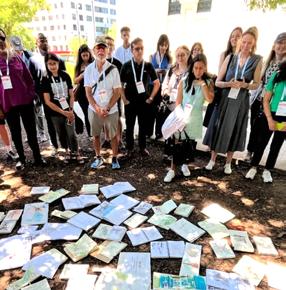
AIA CALL FOR VOLUNTEERS IS OPEN
Are you looking to be a mentor to up-and-coming leaders, shape the future of the architecture profession, join AIA national committees, awards juries (including Jury of Fellows), leadership groups, advisory councils, codes and standards, or AIA Knowledge Communities? Complete the application before June 16, 2025. https://www.aia.org/career-growth/volunteer-at-aia/ volunteer-opportunities


REGIONAL UPDATES
AIA Georgia held a De-Mystifying Fellowship Workshop on April 17. We also have an active AIA GA Fellowship Applications Review Committee that will be meeting with candidates throughout the year to help advise candidates on their applications. This September, we have a regional CoF EP Mixer planned in Asheville during the annual ASPIRE Conference. And in October, we are planning a CoF Mentors and Mentees Social Event. - Mark Levine, FAIA
CALL FOR CONTRIBUTORS
The COF Executive Committee and editorial team invite you to contribute to upcoming editions of the Quarterly. We welcome the submissions of relevant content that aligns with our theme for each issue (Q3: Mentorship, Q4: Research).
For more information visit: https://forms.gle/mbByMsDeyAC565a58
Remembering Chancellor Raymond “Skipper” G. Post, Jr, FAIA
By Ron Blitch FAIA, 2024 Chancellor

Imet Skipper when I was in my early high school years when I was shadowing my Dad, J. Buchanan Blitch FAIA. My Dad was the only two term President of the Louisiana Architects Association (now AIA Louisiana) and I was making signs, running errands and running carousel projectors at seminars, watching and learning who the important leaders of the profession in Louisiana were, and Skipper was at the top of that list. Skipper was mentored by my Dad, and I was mentored by Skipper. His wonderful partner Bryan was a dear friend of my Mom's - they would also manage all the auxiliary activities at Conventions and Conferences.
There are maybe 5 or 6 architects in the last 50 years in Louisiana who were the leaders in design, ethics, service to AIA, and dedicated to community service. Skipper and my Dad were two of them - Skipper always encouraged me to apply for Fellowship (and he put my medal on when I became a Fellow in 1999) and he spoke for my Dad when he got the AIA Louisiana Gold Medal in 2009 (posthumously) and for me when I received it in 2015.
Thank you, Skipper.
Skipper could never say no when asked to volunteer or support a cause (he usually ended up as Chair - and encouraged

Photo Above Courtesy of AIA.
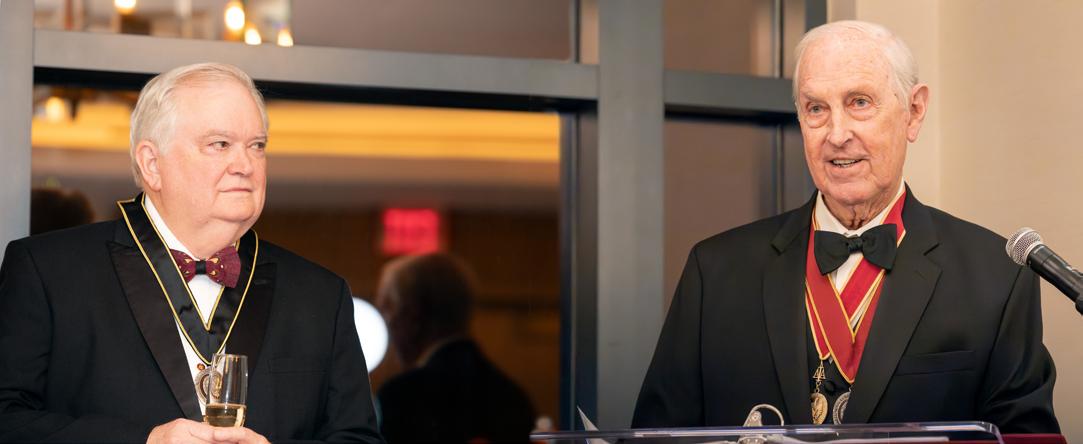
others to happily assist). He was instrumental in creating the Louisiana Architects Selection Board - that effectively minimized politics in the selection of architects for public work in the State - allowing "non-political" architects to work on major projects for the first time in history. The Selection Board continues to function today and has resulted in better projects for the State by architects who would not have had a chance before the early 1970's to participate in these projects.
Thank you, Skipper.
When I was inaugurated as Chancellor of the College of Fellows in December 2023, Skipper gave me a wonderful testimonial while Bryan was home unable to travel.
Thank you, Skipper.
Skipper was a dear friend you could trust and rely on, passionate about architecture and AIA, always wanting to move the ball forward and improve things, resulting in great frustration at times. He never failed to continue to try, and to encourage and inspire the continuation of the fight in the rest of us. We had so many intense discussions about "fixing AIA".
Thank you, Skipper.
Skipper and my Dad are now together redoing the master plan for heaven and ensuring that ethics, inclusion, excellence, and caring are at the forefront.
Thank you, Skipper.
Personal remembrances from others:
RonAltoon,FAIA
"Skipperwasastatesmanamongleaders,agood listeneramongspeakers,aquietandsteadyvoicein times of calm and dissonance. His demeanor will be

missed to be sure."
RonSkaggs,FAIA
"Agentlemanarchitectlovedbyallwhoknewhim."
CarlElefante,FAIA
"Wewereallveryfortunatetohavehadthe opportunitytoserveinAIAwithSkipper.Heinspired usallandelevatedusbyhisexample."
GeorgeMiller,FAIA
"Skipperwasapillarofourprofession,anexampleof a life well lived."
Photo Above Courtesy of AIA. Skipper Post, FAIA (bottom right) and former AIA Presidents in the AIA Headquarters building , December 2017.
Photo Above Courtesy of AIA. Skipper Post, FAIA speaking at the inauguration of 2024 Chancellor Ron Blitch, FAIA.
JohnCastellana,FAIA
"Skippertouchedsomanyofusandhismemorywill alwaysbecherished."
KateSchwennsen,FAIA
"Hewasawiseandgenerousmentortosomanyof us,alwaysrecognizingandchampioningindividual potential,andalwaysinservicetotheprofessionand Institute. I’llmissmanythingsabouthim,including hisdeepmelodiousSouthernvoice."
EdKodet,FAIA
"TomeSkipperwasaspecialperson. Hewasleader thatlookedoutforthegreatergood. Hisfocus onadvancingthearchitecturalprofessionsetsa standard for all. He was the resource that we looked atwhendirectionswerefragmented,andstabilitywas needed."
JoshFlowers,FAIA
"Skipperwasaninspiringleaderandmentor.Iwillbe thinkingofSkipperwithaheavyheartasweprepare torecognizehimposthumouslyinBostonasthe KemperAwardrecipientandwillalsolookforwardto celebratinghislegacywithmanyfriendswhoknew him and served with him at all levels."
TedPappas,FAIA
"OneoutstandingattributethatSkipperpossessed waskindness.Hewaskindtoeveryone."
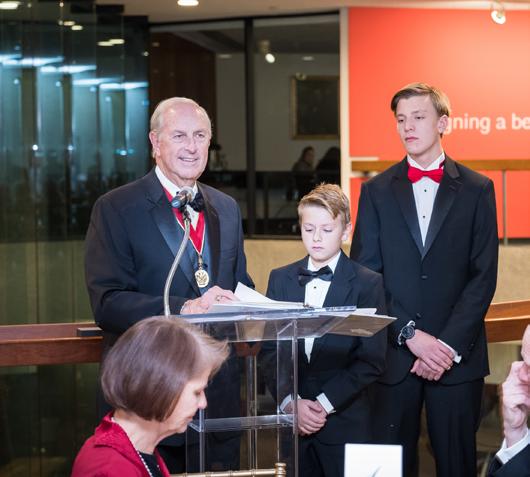
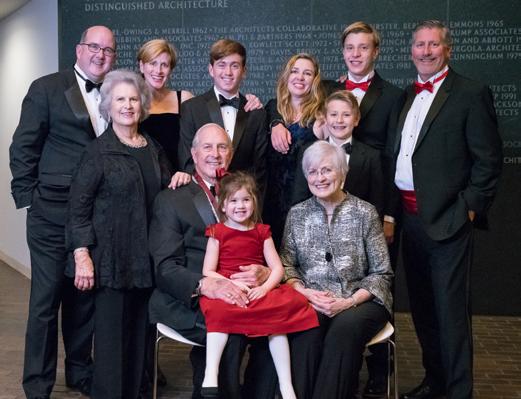
EdVance,RA
"Hewasaleaderamongleaders,yetheledwith humility,neverseekingthespotlight,always illuminatingthepathforwardforothers.Hehadan enormouscapacitytogiveofhimselfandIcan’ttell youhowmanypeoplehavetoldmethatSkipper becameamentorandafatherfigureintheirlife.I wascertainlyoneofthem."
BetsyOlenickDougherty,FAIA
"Skipperistheperfectexampleofthelegaciesthat wecaneachleavebehindtoenrichourprofession and our communities."
Raymond “Skipper” Post, FAIA, was honored with the 2025 Edward C. Kemper Award - the highest service award AIA can confer upon a member, recognizing significant impact on the profession through service to AIA or an architecture-related organization.
"Across the span of nearly 60 years, Raymond “Skipper” Post, FAIA, has dedicated himself to advancing AIA and the profession at all levels. Through extensive community and organizational service, Post has bolstered the public’s perception of architects’ work while simultaneously operating a productive office dedicated to design excellence. His seemingly inexhaustible vigor and enthusiasm have led to countless meaningful appointments, and his leadership has profoundly influenced his colleagues and the built environment."
Photo Above Courtesy of AIA.
Skipper Post, FAIA and his family at his Inauguration as the 56th Chancellor of the College of Fellows.
Photo Above Courtesy of AIA.
Skipper Post, FAIA and his family at his Inauguration as the 56th Chancellor of the College of Fellows.
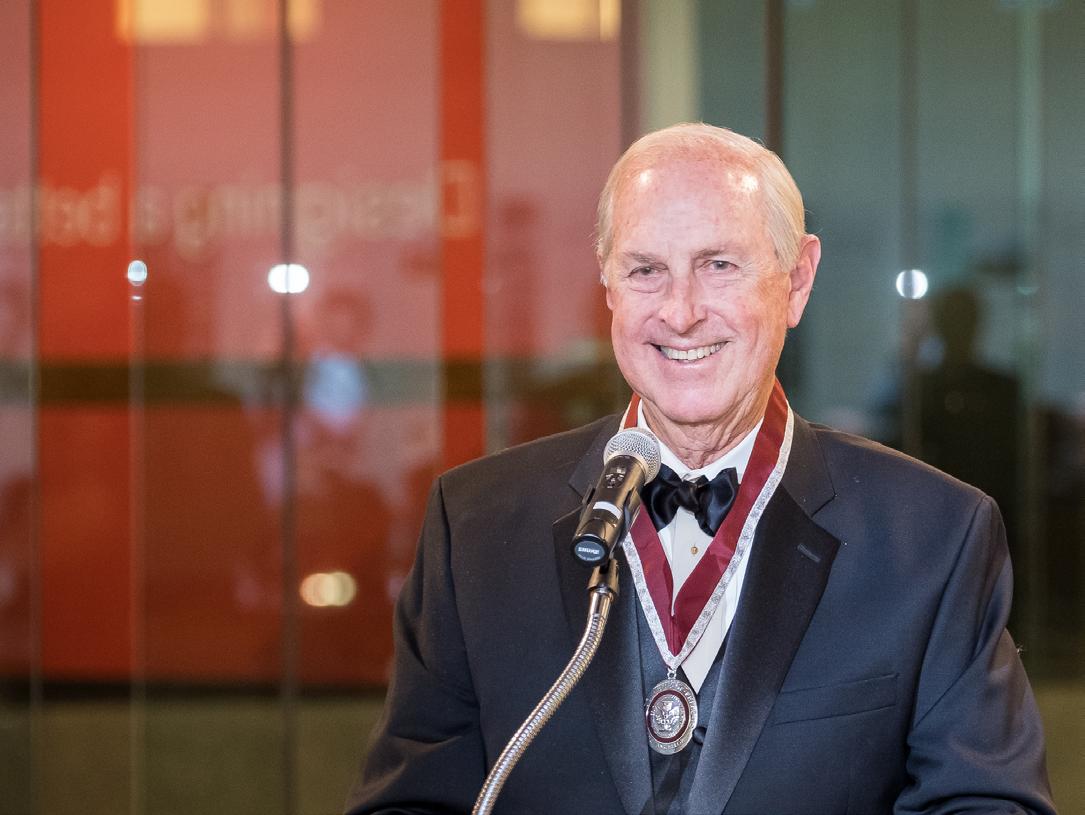
Raymond "Skipper" G. Post Jr., FAIA
November 3, 1939 – March 14, 2025
On behalf of all who knew Raymond "Skipper" G. Post Jr., FAIA, we extend our heartfelt condolences to his family and loved ones. Skipper was a visionary leader who transformed our profession and community through his exceptional work and inspiring mentorship.
From revitalizing Baton Rouge's downtown to serving as the 72nd president of the American Institute of Architects, Skipper’s legacy is one of excellence, resilience, and purpose. His passion for architecture and his deep connections with others left an indelible mark on every life he touched, every project he led, and every future architect he inspired. Skipper’s lifelong service and dedication to the profession was recognized with the 2025 AIA Kemper Award – his family will accept the award on his behalf at AIA25 in June.
While we mourn his loss, we honor a life filled with wisdom, kindness, and boundless dedication to his craft, family, and community.
Evelyn Lee, FAIA
Stephen T.
Ayers, FAIA
2025 President Interim Executive Vice President and CEO
To learn more about the life and impact of Skipper Post, FAIA, visit https://www.dignitymemorial.com/obituaries/baton-rouge-la/raymond-post-12284704 and https://www.aia.org/design-excellence/award-winners/raymond-skipper-post-faia-honored-2025-edward-c-kemper-award
Photo Above Courtesy of AIA. Skipper Post, FAIA giving his inauguration speech as 56th Chancellor of the College of Fellows.
A Fellows Guide to

Our June Conference on Architecture and Design is packed with learning opportunities for architects in all stages of their career, including a number of events sponsored by the College of Fellows. We look forward to catching up with each of you at our various events and welcoming in the new class of Fellows. We'll see you in Boston!

Wednesday, June 4, 2025
1:30pm - 3:30pm
AIA Annual Meeting - EV104
Boston Convention & Exhibition Center, Ballroom West
Add your voice to the conversation shaping the future of The American Institute of Architects. Candidates for office will be presented, delegates will vote on amendments to AIA bylaws and resolutions, and updates will be shared on the state of AIA at this critical annual meeting.
4:00pm - 5:00pm
Candidate Caucus
Boston Convention & Exhibition Center, (rooms vary by state/ territory)
How well do you know the candidates running for elected AIA board positions? Join peers and colleagues to assess AIA's future leadership as candidates present their platforms and goals for service.
Photo Above Courtesy of AIA: AIA24 Inspire: Camp AIA sketching session in Washington DC's Penn Quarter.
Thursday, June 5, 2025
10:00am -4:00pm
Empowered by Design: High School Charrette - EV108
Boston Convention & Exhibition Center, by the AIA Design Shop
You're invited to partner with the AIA College of Fellows in empowering the next generation of designers and community leaders. High school and college students will join you to sharpen their problem-solving skills, enhance their creative thinking, and strengthen their teamwork by working through a design challenge. Stop by for 15 minutes or 2-hours to join in this engagement opportunity.
11:30am - 1:00pm
Honoring Excellence: Fellows Luncheon
Omni Hotel
The Fellows Luncheon will celebrate the induction of new AIA Fellows and allow you to engage in networking opportunities with colleagues. The location is being finalized and will be shared soon. This event includes new Fellows, current Fellows, Former Chancellors and Former Presidents.
1:00pm - 1:30pm
Fellows Investiture Rehearsal
Trinity Church in the City of Boston, 206 Clarendon Street
New Fellows, COF ExComm, AIA Former Presidents and COF Former Chancellors will take part in a rehearsal and 2025 Fellows will take a class photo at this time.
2:00pm - 4:00pm
Fellows Investiture Ceremony and Recognition Celebration - EV126
Trinity Church in the City of Boston, 206 Clarendon Street
We are excited to share that Investiture will be held at the Trinity Church. New Fellows and their guests do not need to register or get a ticket. Please make sure to tell your friends, family, and loved ones they do not need to pay or register for the conference to come cheer on the new Fellows. Transportation from the Boston Convention Center will be provided for your friends and family. Doors will open at 1:30pm.
6:00pm - 9:00pm
AIA Awards Gala - EV130
Omni Boston at the Seaport, Ensemble Ballroom
(*Black tie optional)
This evening showcase of architectural excellence will shine a light on the 2025 College of Fellows inductees and the remarkable achievements of our AIA award winners in a celebration of excellence, innovation, and impact. The cocktail reception begins at 6pm, followed by dinner and the awards presentation at 7pm. (Registration to the Gala includes admission to the AIA After-Party)
9:00pm - 11:00pm
AIA Awards Gala After Party - EV131
Omni Boston at the Seaport, Momentum Ballroom
Keep the celebration going! Enjoy a night of music, mingling, and unforgettable moments with the 2025 AIA award winners and Fellows.
Friday, June 6, 2025
10:00am - 12:00pm
Inspire: Camp AIA - EV132
Boston Convention & Exhibition Center, by the AIA Design Shop
Designed in partnership with the AIA College of Fellows, local elementary school students will explore short series of creative activities that include learning what architects do, building problem-solving skills, and taking part in hands-on design activities. Stop by for 15 minutes or 2-hours to help inspire future architects and designers.
12:00pm - 1:30pm
COF Regional Representatives Lunch Meeting (by invitation only)
Regional Representatives are invited for a lunch meeting. For more information, contact Muza Conforti.
4:00pm - 5:15pm
2 + 2: Achieving Outstanding Design - FR400
Boston Convention & Exhibition Center, 205AB
What are the elements of outstanding design, and how can they help your practice stand out from competitors? This seminar will feature widely recognized, accomplished members of the College of Fellows and recent recipients of the Young Architects Award.
5:30pm - 7:00pm
Celebration With the Fellows - EV146
Payette, 290 Congress Street, 5th Floor
Join us to toast new Fellows as you enjoy the company of colleagues and friends from near and far. You'll make new friends and rekindle old connections. Event proceeds will benefit the AIA College of Fellows Fund in support of the Latrobe Prize and COF Component grants.
Saturday, June 7, 2025
10:30am - 12:30pm
Priming the Pipeline: Inspiring High School students Through Internships & ArchWeek Engagements - SA306
Boston Convention & Exhibition Center, 210B
Designed in partnership with the AIA College of Fellows, this interactive workshop will discuss the essential principles of hosting high schoolers in design firms, review examples of successful projects, and brainstorm new model.
10:30am - 11:45pm
Common SENSES: Building Equity Through Sensor Data & Participatory Modeling - SA212
Boston Convention & Exhibition Center, 210C
This session will present processes and lessons from the research project funded by the 2022 Latrobe Prize (awarded by the AIA College of Fellows). The panel of researchers, city planners, and practitioners will discuss a science-based and equity-focused approach to designing green infrastructure in architecture projects to improve microclimates and mitigate environmental hazards.
Chancellor's Cup Tournament Update
By RK Stewart, FAIA


As 2025 began, the College of Fellows Executive Committee asked me to Chair the Fellows Golf Committee. Since 1997, when Former Chancellor Al Rubeling, Jr, FAIA initiated the Chancellor’s Cup Tournament in New Orleans, it has been overseen by the Committee. As a fundraiser for the College it occurs before AIA’s Conference each June. Over its history the Tournament has offered Fellows and members the opportunity to play some wonderful courses while enjoy some friendly competition. Or not so “friendly” as the fight for bragging rights heat up!
As our work to organize the Tournament in Boston this year progressed, questions were raised about the municipal course that had been publicized as our venue. Upon further investigation the Committee found its facilities to host our group were undersized and very limited. The course itself is not rated as highly as our past venues and unlikely to offer the player experience that we've come to expect. Throughout January, February and March we searched for a new venue, contacting 18 public and private courses to check availability, capacity, facilities and catering. It was middle of the winter and the courses often buried under snow. Responses to our questions were often slow to arrive as their staffing was reduced. Many courses said they do not host outside events, others could not accommodate our date, and others would not deliver the kind of experience we sought. As we reached the end of March, when we'd typically open player registrations, the Committee concluded an appropriate venue was not going
to be found. The Committee reluctantly recommended to the College's Executive Committee that rather than damage the reputation of the Tournament with a sub-par experience we should cancel this year's event and focus on offering a spectacular Tournament in San Diego in 2026. The Executive Committee accepted our recommendation.
We are now developing a plan focused on next year's Tournament in San Diego. A long list of possible venues is being compiled and research into their suitability and availability has begun. We will also be collaborating with AIA San Diego as we explore options for the Tournament. If you have a recommendation for a great venue, particularly if you are a Fellow in San Diego, please do not hesitate to contact me or Muza Conforti, the Executive Director of the College. With the fantastic weather that San Diego is famous for and the number of highly ranked courses in the area we are optimistic that we'll be able to make the wait the 2026 Chancellor’s Cup worthwhile.
Watch for updates from the Committee on planning for the Tournament in the months ahead. If you have other questions or concerns, please let me know at rk@rkstewartconsultants.com. Until then I hope your drives find the fairway and all your putts fall this summer.

Feature | Why We Give
2025 Component Grant Recipients
Congratulations to this years recipients!
We look forward to sharing your final program reports in an upcoming issue of COF Quarterly.
Help make programs like this possible by donating or honoring someone with a gift to the College of Fellows Fund today!

Inspiring
the Next Generation of Architects through K-12 Learning and Mentorship

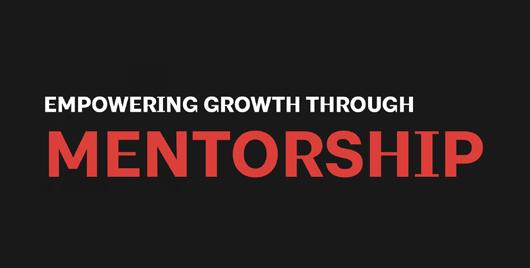
Boston Society of Architects
This High School Internship addresses significant gaps in design education for underserved communities by fostering awareness of the built world, teaching critical thinking skills, and introducing students to career pathways in architecture and design. Our 6-week internships are available to rising high school sophomores, juniors and seniors in Boston Public Schools who are paired with an AIA member architect mentor and participate in a structured program that introduces them to day-to-day project activities, site visits, client meetings, and design discussions.
Empowering Growth through Mentorship
AIA Cleveland & Young Architects and Associate Members Committee (YAAM)
By leveraging the expertise and insights of seasoned professionals, we aim to bridge the gap between education and practice, equipping young architects with the knowledge and relationships necessary to excel in their careers. Expanded mentorship opportunities, career-building workshops, and structured networking events will provide the foundation for lasting professional relationships and skill development.



New World Architects Summer Camp: An Immersive Summer School Architecture Program for Youth Scholars
AIA East Bay
This one-week summer program will introduce 20-25 youth scholars, aged 10-14, to architecture, design, and the built environment. Hosted at UC Berkeley’s College of Environmental Design, the program engages students from underserved Bay Area schools. Entirely staffed by volunteer architects and designers, it fosters mentorship and collaboration to create pathways into the profession for youth of color and those from underrepresented backgrounds.
Executive Leadership Program
AIA Honolulu
This program is designed to help train and nurture Hawai‘i’s next generation of design industry leaders. Through 9 individual all-day workshops over a 9-month period, participants will develop skills to advance their career and contribute to the future success of the industry. The program format allows participants to absorb what is learned and apply it to their jobs in the time between sessions. In between course sessions there may be additional reading, small group assignments, or other homework to enhance the learning experience.
Bridging the Gap: Mentorship for Emerging Architects
AIA Marianas
This program was established to further support the growth, development, and encouragement of these future architects. This initiative aims to create an inclusive and dynamic environment for emerging architects and underrepresented groups within the profession. The program’s goals include:
1. Engaging with K-12 students through public outreach activities such as school presentations, competitions, and/ or activities.
2. Connect emerging professionals and professionals through mentoring partnerships, workshops, and professional networking opportunities.

Mentor Series for Advancing Leaders
AIA North Carolina
This series will combine practical insights and training with invaluable insights from mentoring firm leaders and AIA Fellows by establishing ongoing avenues for mentoring style (business and management-focused) programming for AIA North Carolina EP members in leadership roles. These sessions will be tailored to deliver insights architects can immediately apply to their practice of architecture. The format prioritizes delivery of this content in a way that is accessible for young architects across the state.

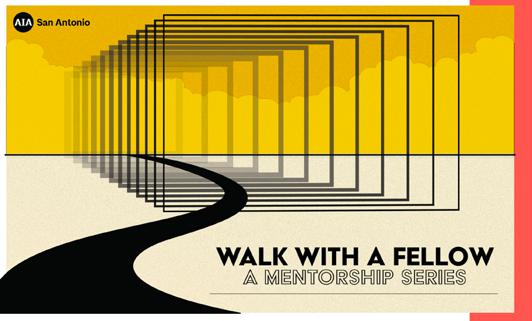

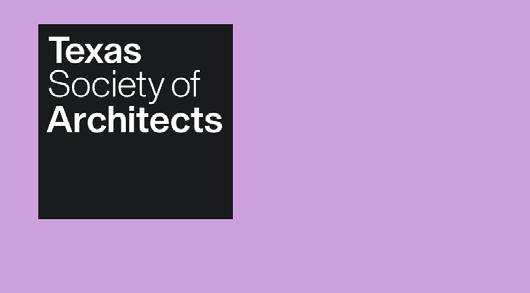
AIAPR | CKLDP Scholar’s ClifftonStrength Assessment, Coaching and FAIA Mentorship
AIA Puerto Rico
As part of the program, 16 scholars will be divided into 8 pairs that would plan, develop and host each CKLDP Session. This year we will be encouraging these eight pairs of scholars to be mentored by 8 local AIA Fellows to develop their session. For the session titled “Working Together”, we have designed the curriculum so that our scholars will benefit from a tailored leadership assessment, The Clifton Strength Assessment. This self-reflecting exercise will help our scholars discover what they do best, learn how to develop their talents into strengths and used the personalized results to maximize their potential.
Walk with a Fellow: A Mentorship Series Program Expansion
AIA San Antonio
This bi-monthly series creates an intimate space for the Fellows to share their talents, stories and wisdom through craft, storytelling and mentorship. This innovative series features sessions on sketching and photography and walking tours award-winning projects to inspire emerging professionals. With a backlog of 12+ fellows eager to lead sessions, we are expanding this programming with tours of award-winning projects outside of San Antonio designed by the San Antonio members of the College of Fellows Committee.
Mentorship Panel Series
AIA Springfield
These panels connect young professionals, students, and experienced leaders with a range of speakers that are experts in their respective disciplines. The goal is to create an inclusive and supportive platform where participants can engage with experts, gain insights, and receive guidance on project development, project planning, and overcoming professional challenges as a team. This panel will provide direct access to a wealth of knowledge from the consultants that we work with regularly but with a platform to have an honest conversation on how we can all work better together and what all architects could benefit from understanding better in regards to their scope of work.
Texas Emerging Leaders Programming
Texas Society of Architects
The Emerging Leaders Grassroot (ELG) sessions serve as one of the main professional development opportunities for young architects, associates, and students across Texas. This event will give emerging professionals and students an opportunity to network with their peers, gain mentorship from colleagues at various levels, interact with role models in the profession such as our Texas Fellows, as well as gain critical knowledge and tools to apply as emerging leaders in their communities. ELG is open to anyone who wishes to participate.
Governance Task Force:
• Mickey Jacob, FAIA, Chair (Former President)
• Anne Hicks Harney, FAIA (Director at-Large)
• Anthony Rohr, FAIA (Member at-Large/LFRT)
• Carol Rickard-Brideau (Member at-Large/LFRT)
• Cheryl McAfee, FAIA (Member at-Large)
• Curt Wilson, AIA (Member at-Large)
• Darral Tate, AIA (Young Architect/SAC Rep)
• Gabriella Bermea, AIA (Member Group)
• Curt Wilson, AIA (Member at-Large)
• Darral Tate, AIA (Young Architect/SAC Rep)
• Gabriella Bermea, AIA (Member Group)
• Heather Wilson (CACE 2025 President, Strategic Councilor)
• Jeffrey Gill, FAIA (CACE Executive Committee)
• Jessica O’Donnell, AIA (Strategic Council Moderator)
• Leah Alissa Bayer, AIA (Member at-Large)
• Nicki Dennis Stephens, Hon. AIA (CACE)
• Susan Chin, FAIA (Knowledge Community)
• Susan Wyeth, AIA (Resolution Sponsor)
• Timothy Hawk, FAIA (Past Board of Directors)
• Stephen Ayers, FAIA, ex officio (CEO)
• Heather Wilson (CACE 2025 President, Strategic Councilor)
• Stephen Ayers, FAIA, ex officio (CEO)
• Jeffrey Gill, FAIA (CACE Executive Committee)
Key Outcomes from the First Meeting
• Jessica O’Donnell, AIA (Strategic Council Moderator)
• Leah Alissa Bayer, AIA (Member at-Large)
Key Outcomes from the First Meeting
• Nicki Dennis Stephens, Hon. AIA (CACE)
• Susan Chin, FAIA (Knowledge Community)
• Susan Wyeth, AIA (Resolution Sponsor)
• Timothy Hawk, FAIA (Past Board of Directors)
Date: April 11, 2025
• Clarification of Charge and Timeline: The Task Force aligned charge, roles, and anticipated milestones, and reviewed the broader governance changes dating back to the 2013 restructuring.
• Clarification of Charge and Timeline: The Task Force aligned on its formal charge, roles, and anticipated milestones, and reviewed the broader context of governance changes dating back to the 2013 restructuring.
• Working Agreements: The group was created and committed working agreements and ground rules to guide how members throughout the year.
• Working Agreements: The group was created and committed to a shared set of working agreements and ground rules to guide how members will collaborate throughout the year.
• Assessment of MVTF Progress: Members engaged in an exercise progress made on the MVTF’s past recommendations, identifying ongoing areas for improvement.
AIA Board of Directors
• Assessment of MVTF Progress: Members engaged in an exercise to evaluate progress made on the MVTF’s past recommendations, identifying key wins and ongoing areas for improvement.
• Commitment to Inclusive Process: The Task Force emphasized a transparent, inclusive, and feedback-informed process, identifying touchpoints with member groups, Knowledge Communities, and bodies.
From: Mickey Jacob, FAIA, Chair, Governance Task Force; Caitlin Couture, CAE, Senior Director, Governance & Awards
Subject: Update on the Governance Task Force Work
• Commitment to Inclusive Process: The Task Force emphasized its dedication to a transparent, inclusive, and feedback-informed process, identifying potential touchpoints with member groups, Knowledge Communities, and governance bodies.
Next Steps
Background
Next Steps
The Governance Task Force will meet monthly throughout 2025 and Board with its recommendations based on findings developed in partnership external governance consultant. The task force will provide a report with recommendations to the AIA Board of Directors in December 2025.
The Governance Task Force will meet monthly throughout 2025 and will provide the AIA Board with its recommendations based on findings developed in partnership with an external governance consultant. The task force will provide a report with recommendations to the AIA Board of Directors in December 2025.
Governance Task Force (GTF), was established by the AIA Board of Directors in response to a 2024 resolution approved by the membership, convened for its inaugural meeting on March 31, 2025. The group was formed to assess the effectiveness of AIA’s governance structure, ensure it continues to reflect the needs of the membership, and build on past recommendations particularly those of the Member Voice Task Force (MVTF) with a renewed commitment to transparency, inclusion, and crossorganizational collaboration.
The next major milestone for the Governance Task Force is a series interviews to be conducted in collaboration with governance consultants Advisors. These interviews will ensure a diversity of perspectives across career stage, and member type are incorporated into the assessment.
The next major milestone for the Governance Task Force is a series of stakeholder interviews to be conducted in collaboration with governance consultants from McKinley Advisors. These interviews will ensure a diversity of perspectives across geography, career stage, and member type are incorporated into the assessment.
Governance Task Force is charged with working with an external governance consultant and AIA staff to conduct a governance assessment, examine AIA’s current governance structure, and provide recommendations to enhance communication across Institute and cultivate a culture of trust and transparency.
Governance Task Force:
Additionally, the Governance Task Force will contact all the represented stakeholder groups directly to report the activities of each meeting and develop an information distribution process for each group with their leadership representatives. This information will be distributed after each meeting of the Governance Task Force or when pertinent activities to the group's charges have been addressed.
Mickey Jacob, FAIA, Chair (Former President)
Anne Hicks Harney, FAIA (Director at-Large)
Anthony Rohr, FAIA (Member at-Large/LFRT)
Carol Rickard-Brideau (Member at-Large/LFRT)
Additionally, the Governance Task Force will contact all the represented groups directly to report the activities of each meeting and develop an distribution process for each group with their leadership representatives. information will be distributed after each meeting of the Governance Task pertinent activities to the group's charges have been addressed.
Also, the Governance Task Force will institute a vehicle in which the and AIA Members can offer comments, suggestions, and/or ideas to considered in the Governance Task Force's deliberations. Our team will to participate in this process as soon as we implement it
Also, the Governance Task Force will institute a vehicle in which the stakeholder groups and AIA Members can offer comments, suggestions, and/or ideas to be reviewed and considered in the Governance Task Force's deliberations. Our team will provide the link to participate in this process as soon as we implement it
Cheryl McAfee, FAIA (Member at-Large)
Curt Wilson, AIA (Member at-Large)
Darral Tate, AIA (Young Architect/SAC Rep)
The Task Force will continue to provide regular progress updates to AIA stakeholder groups, and membership, with the next update scheduled the AIA Townhall on May 16, 2025.
The Task Force will continue to provide regular progress updates to AIA leadership, stakeholder groups, and membership, with the next update scheduled to be shared at the AIA Townhall on May 16, 2025.
Gabriella Bermea, AIA (Member Group)
Heather Wilson (CACE 2025 President, Strategic Councilor)
Jeffrey Gill, FAIA (CACE Executive Committee)
Jessica O’Donnell, AIA (Strategic Council Moderator)

Memorandum
Date: April 28, 2025
To: AIA Board of Directors
From: Mickey Jacob,
FAIA, Chair, Governance Task Force; Caitlin Couture, CAE, Senior Director, Governance & Awards
Subject: Update on the Governance Task Force Work
On April 28, 2025, the Governance Task Force held its second meeting to advance discussions on AIA's governance structure. The meeting focused on planning stakeholder interviews, identifying key themes for exploration, prioritizing stakeholder groups, and developing a communications strategy to support ongoing transparency and engagement
Key themes and discussion points
• Reflections and approach: The task force continued its discussion from the first meeting, reflecting on perceptions of AIA’s existing governance structure, including the defined, communicated, and lived roles of the Board and Strategic Council. Members of the Task Force emphasized that rebuilding foundational elements transparency, communication, and trust is critical to AIA's future governance effectiveness.
• Stakeholder engagement: McKinley Advisors, AIA’s governance consultant, will lead a series of stakeholder interviews. The task force reviewed and discussed engaging broader stakeholder input and identified key themes to explore in the interviews, including member input and engagement in decisionmaking, representation of stakeholder groups, and effective communication channels. The interviews will also assess stakeholder awareness of AIA’s current governance structures and opportunities for leadership and engagement. All questions will be framed with a forward-looking perspective.
• Communication and transparency: The task force reaffirmed its commitment to transparency and proactive communications throughout the process. The task force discussed potential communication vehicles to share updates and ensure broad stakeholder awareness. Task Force members will continue to serve as communication liaisons, sharing regular updates with their respective stakeholder groups. A comprehensive communications strategy will be developed and implemented to support this work further.
Next Steps
McKinley Advisors will begin outreach to the identified stakeholder groups to invite individuals to participate in the interview process. The stakeholder interviews will be completed for the Governance Task Force meeting in June 2025. Mickey Jacob, FAIA, Chair, Governance Task Force, will update the AIA delegates during the Annual Business Meeting on Wednesday, June 4, 2025, in Boston. The task force will continue to provide regular progress updates to AIA leadership, stakeholder groups, and membership.
Feedback and questions related to the Governance Task Force’s work can be sent to boardofdirectors@aia.org.
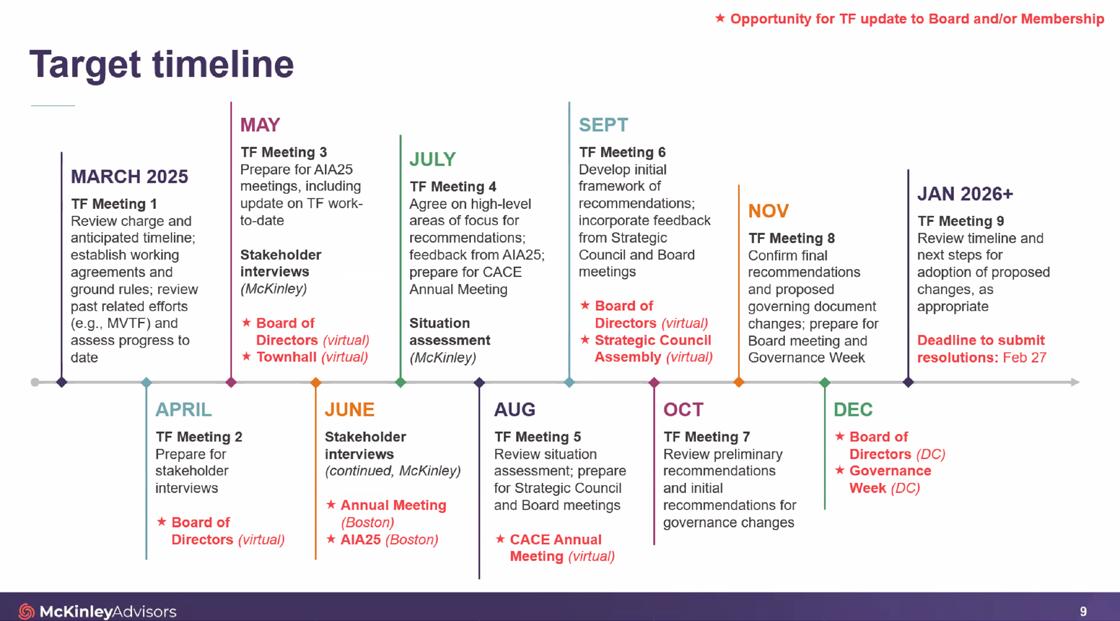
Image Above: Working Governance Task Force Timeline.
Mini MBA Series

2024 COF Component Grant Recipient
AIA Triangle
Help make programs like this possible by donating or honoring someone with a gift to the College of Fellows Fund today!

EXECUTIVE SUMMARY
The AIA Triangle Mini-MBA Series was designed to address gaps between design education and professional practice by equipping mid-career design professionals with essential business skills. This six-session program, held from April to October 2024, provided an overview of critical topics such as organizational development, financial management, marketing, and human resources, supplemented by interactive panels, networking opportunities, and mentorship from AIA Fellows and local experts. Fourteen participants engaged in discussions, case studies, and hands-on activities, leading to enhanced leadership skills, practical business knowledge, and a deeper understanding of the strategic aspects of running a design practice. Feedback highlighted the program’s relevance and scalability for the future.
GRANT OBJECTIVES
• Objective 1: Provide mid-career design professionals with foundational knowledge in business management and leadership to bridge the gap between academia and practice.
• Objective 2: Facilitate mentorship opportunities and knowledge sharing between AIA Fellows, local experts, and participants, fostering a collaborative learning environment.
• Objective 3: Develop a scalable and replicable program model to expand access to professional development resources across the region and beyond.
USE OF FUNDS
The $8,000 grant supported critical program expenses, including speaker fees, session recordings, venue rentals, and program materials. Initially, funds were allocated for participant financial assistance, ensuring accessibility for individuals who may have faced financial barriers, however the group did not require financial assistance, so these funds were reallocated to allow for additional “office hours” events to increase peer-mentorship and networking with AIA Fellows. The resources from the College of Fellows Component Grant greatly enhanced the quality and reach of the program, allowing for a robust learning experience and creating materials for future use.
PROGRAM ACTIVITIES
Activity 1: Program Kickoff Session Completion
Date: April 16, 2024
Results/Outcomes: Participants connected with AIA Fellows, local leaders, and peers, creating a foundation for collaboration throughout the program. Participants engaged in talent assessments (e.g., CliftonStrengths and Enneagram), and were given an overview of the program.
Activity 2: Organization Design Session Completion
Date: May 21, 2024
Results/Outcomes: Participants explored strategies to enhance firm effectiveness, leadership, and team dynamics.
Activities and discussions provided actionable approaches to improve organizational performance
Activity 3: Marketing & Business Development Session
Completion
Date: June 18, 2024
Results/Outcomes: Participants learned how to articulate their firm’s identity and value through storytelling and strategic marketing. A writing exercise with expert feedback helped them refine communication skills critical for business growth.
Activity 4: Financial Management Session Completion
Date: August 20, 2024
Results/Outcomes: Participants deepened their understanding of financial metrics, planning, and risk mitigation. Group exercises on key performance indicators equipped them with practical tools to assess and improve firm financial health.
Activity 5: Human Resources & Legal Resources Session
Completion
Date: September 24, 2024
Results/Outcomes: Presentations and Q&A sessions covered topics like employee retention, recruitment, and legal considerations in design practice. Participants gained clarity on HR management and compliance issues to better navigate workplace challenges.
Activity 6: Program Close & Diploma Distribution Completion
Date: October 15, 2024
Results/Outcomes: Participants reflected on lessons learned and celebrated their achievements with peers and mentors. Feedback collected during the session will inform future iterations of the program to further improve its impact.

Activity 7: Office Hours Events Completion
Dates: July 25, 2024, and October 3, 2024
Results/Outcomes: Informal "office hours" events offered participants additional opportunities to engage with AIA Fellows and local leaders, outside of the core sessions, in a more casual setting. These gatherings provided valuable insights, strengthened peer-to-peer connections, and encouraged open discussions on professional challenges and solutions.
OUTCOMES AND IMPACTS
Beneficiaries: Immediate beneficiaries were the fourteen midcareer design professionals from North Carolina’s Triangle region, from a variety of firm sizes and types, with diverse experience across public and private sectors. Additional future beneficiaries are anticipated due to the session recordings, made possible by the College of Fellows Component Grant, which will be made available online, to allow for greater program reach to neighboring regional and state chapters. Key Achievements: Participants gained actionable business knowledge, improved leadership skills, and strengthened relationships with AIA Fellows and local leaders. Practical takeaways included insights into financial planning, organizational strategy, and marketing approaches. LongTerm Impact: The program created a replicable model for professional development, fostering a culture of mentorship and preparing participants for firm leadership and entrepreneurial ventures. Recorded sessions and materials will extend the program’s benefits to a wider audience.
CHALLENGES AND LESSONS LEARNED
One of the more significant challenges faced was the limited amount of time set for each session; the two hour session time allotted at the outset of the program afforded enough time for only high level introductions to many of the session topics. In order to address the issue, sessions were supplemented with reading materials and lists of resources for further study, such as podcasts and online articles. Another key challenge was coordinating schedules for participants, speakers, and facilitators, which was addressed through proactive planning and clear communication. Feedback highlighted the value of informal networking opportunities, leading to the addition of “office hours” sessions. Lessons learned included a need to focus on balancing structured learning with opportunities for peer-to-peer interaction and the potential for extending session lengths or adding supplementary materials to deepen engagement.
FUTURE PLANS
The AIA Triangle Mini-MBA Series is designed to be replicable and scalable, in order for future iterations to reach a broader audience. Future plans consider repeating a similar offering of this program every other year, offering the recordings of this year’s program sessions to other local or regional components such as AIA NC, AIA Charlotte or AIA Asheville, and exploring hybrid formats to expand accessibility. Continued collaboration with AIA Fellows and local professionals would be encouraged to sustain mentorship opportunities and ensure the program remains relevant to evolving industry needs.
Photo Above: Office Hours with Design Leaders.
Feature | 2025 Fellow
Interview with Graciela Carrillo, FAIA
By Jessica O'Donnell, AIA
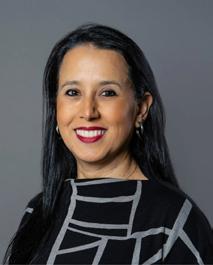
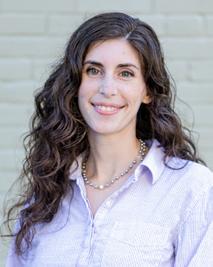
Graciela Carrillo, FAIA, works as a Senior Manager at Nassau BOCES Facilities Services, coordinating the school’s capital and operational projects serving Nassau County school districts.
She is deeply involved with the American Institute of Architects (AIA) at the local, state, and national levels, having served as the 2024 Moderator of the AIA Strategic Council, 2017-2018 Young Architects Forum New York State Director, 2020-2021 President of AIA Long Island, and Co-Founder/Co-Chair of the AIA Long Island Women in Architecture Committee. Currently, Graciela is serving as the AIA 2025-2027 At Large Director.
Graciela is also a Co-Founder of the Immigrant Architects Coalition, a nonprofit dedicated to supporting immigrant architects in advancing their careers. As a national speaker and podcast host, she has co-authored two books "City Shapers: Stories of Immigrant Designers” and “Prospering in the U.S.: A Handbook for Immigrant Architects” and contributed to “Latinas in Architecture”.
Jessica O'Donnell AIA, is the 2025 Editor-in-Chief of the AIA College of Fellows Quarterly publication.
Jessica O'Donnell (JO): Congratulations on being elevated to Fellowship in the Class of 2025! As a Fellow who Led the Institute, what does advancement into the College mean to you?
Graciela Carrillo (GC): Being elevated to the College of Fellows is both a humbling honor and a powerful affirmation. As an immigrant woman architect, this milestone transcends personal achievement—it’s a recognition of collective impact. It validates the work I’ve done to create space for underrepresented voices, and reinforces my commitment to lead with purpose, empathy, and advocacy. I also want to inspire other minorities to pursue fellowship. Representation at all levels is important to set the precedence for more immigrants to apply and be recognized.
JO: What advice would you give to those considering applying for Fellowship?
GC: Start early, and let your story guide the process. Fellowship isn’t just about how long you’ve been involved— it’s about the transformational impact you've made. It’s about the ripple effect your work has had within the profession, community, and AIA. Reflect deeply and honestly: How has your leadership moved the needle? Whose lives have you changed? What legacy are you building? These are the questions that matter.

One of the most valuable things you can do is begin documenting your journey early in your career. Keep track of speaking engagements, interviews, written articles, events you’ve organized, awards, mentorship roles, publications, and leadership accomplishments. Having that archive will not only save time later, it will help you see your own story more clearly.
Surround yourself with a support team. Seek out mentors who can help you reflect, mentees who can speak to your influence, and Fellows who can share their perspective. These individuals can serve as advisors throughout the process. Most importantly, recruit a team of trusted reviewers who will give you honest, constructive feedback. This isn’t just about polishing language—it’s about making sure the message lands with clarity and heart.
JO: As an AIA member and volunteer leader for over a decade, can you describe what inspired your initial engagement in AIA?
GC: Initially, I joined AIA because I was searching for connection. When I arrived in this country, my professional environment was heavily engineering-focused, and I wanted to connect with other architects. Once I joined, I realized the AIA was more than just a professional network—it was a platform for possibility. As I became more involved, I started to see the gaps in representation and the urgent need to create space for voices like mine—immigrant, Latina, female voices that had historically been underrepresented in the profession. That realization shifted everything for me.
It wasn’t enough to just be at the table—I wanted to help shape the table. I saw how the AIA could be a catalyst for change, and I knew I could use it as a vehicle to uplift others, to mentor young professionals, and to advocate for equity, inclusion, and diversity. I started leading initiatives, forming
new committees, mentoring students, and speaking out on issues that mattered to me and to so many others. What began as a search for belonging quickly turned into a mission: to build community, champion women and emerging professionals, and ensure that the future of architecture has equal access to all. Through AIA, I found not only my voice—but a purpose greater than myself.
JO: What is your favorite part of being a volunteer leader with AIA?
GC: Without question—the people. Collaborating with passionate, visionary, and mission-driven individuals has been one of the most enriching and inspiring aspects of my journey with AIA. Whether working at the local, state level or on national initiatives, I’ve had the privilege of building relationships that transcend professional networking— they’ve become bonds grounded in shared purpose, mutual respect, and a collective desire to move the profession forward.
One of the most fulfilling experiences of my volunteer leadership was my time serving first as the New York State Representative to the AIA Strategic Council, and later as Moderator of the Council. That experience was transformative. The Strategic Council brings together a pool of experts, leaders, and innovators from across the country—each offering a unique perspective shaped by their region, their background, and their commitment to elevating architecture and architects. To work alongside such an exceptional group of people, to listen, to learn, and to collectively shape strategic visions for the future of the Institute—it was not only an honor, it was a lesson in the power of collaborative leadership.
JO: You have authored and co-authored several books, including Latinas in Architecture, City Shapers: Stories
Photo Above Courtesy of Graciela Carrillo, FAIA: 2025 Princeton Latinas in Architecture Summit
of Immigrant Designers, and most recently Prospering in the US: A Handbook for Immigrant Architects. What is one key takeaway from those experiences and what advice do you have for others looking to publish a book?
GC: Stories are powerful tools for connection and change. One of the most meaningful takeaways from these experiences has been hearing readers say, “I can relate to this story…” That moment of recognition—of being seen, understood, and validated—is incredibly transformative. A turning point for me was when Alicia Ponce, AIA, founder of Arquitina, invited me to contribute to the first book, “Latinas in Architecture.” That invitation wasn’t just about sharing my story—it opened the door to deeper collaboration among Latinas across the country. It helped spark a wave of momentum and solidarity among women like me, who were working to break barriers in the profession. Most importantly, it helped us focus our collective energy on Arquitinas mission: raising the percentage of licensed Latinas in the U.S.
Another key takeaway is the opportunities for collaboration that publishing creates. Once a book is out in the world, it becomes a platform that brings people together—authors, readers, advocates—who are aligned by a common vision. These books didn’t just exist on a shelf—they became catalysts for conversations, mentorship, speaking engagements, and cross-cultural understanding. For anyone looking to publish a book, my biggest piece of advice is: start with your “why.” You don’t need to have every chapter planned or every detail figured out. What you do need is clarity around the purpose of your story and the audience you want to reach. Also, don’t let the logistics intimidate you. You can work with an editor to ensure your story reads well, and there are many affordable options to publish—whether through a small publishing company or self-publishing

platforms like Amazon.
JO: What leadership initiative are you most proud of and why?
GC: Co-founding the Immigrant Architects Coalition (IAC) alongside Yu-Ngok Lo, FAIA, and Shahad Sadeq, Assoc. AIA is one of the most meaningful and transformative leadership initiatives of my career—and of my life. What began as a shared realization between the three of us has evolved into a non profit organization rooted in support, empowerment, and visibility for immigrant architects across the United States.
We started the IAC because we saw—and personally experienced the challenges that immigrant architects faced. While many conversations were happening around equity, diversity, and inclusion, no formal platform was explicitly dedicated to immigrant architects' unique struggles. These are professionals who often arrive with extensive education, experience, and talent, yet face enormous challenges: from licensing and language challenges to immigration restrictions and a lack of mentorship or cultural belonging within the profession.
What began as a grassroots effort has become a thriving and rapidly growing coalition that provides resources, mentorship, community, and a space to highlight voices of immigrant architects.
Our impact is tangible. We’ve hosted national webinars, published two books, launched a Podcast that amplifies voices, created a mentorship program, offered scholarships, and created pathways for immigrant architects to find guidance and belonging. But more than that, we've helped people feel less alone. We’ve built a community that not only acknowledges the challenges, but celebrates the strength and resilience it takes to overcome them. And it’s about using whatever platform you have to lift others as you climb.

Photo Above Courtesy of Graciela Carrillo, FAIA: Members of the AIA Global Practice Committee who also collaborated as co-authors of the two publications led by Graciela at the Immigrant Architects Coalition.
Photo Above Courtesy of Graciela Carrillo, FAIA: Immigrant Architect Coalition Book Co-Authors after book signing at AIA24.

JO: Describe one of your favorite volunteer initiatives: either one you started personally or one you have participated in?
GC: The Women in Architecture (WIA) Committee at AIA Long Island is, without question, one of the most meaningful initiatives I’ve had the honor of co-founding with Ebru Sulker, Assoc. AIA. It holds a deeply personal place in my heart, not only because of the impact it’s had, but because of how it began—at a moment when I needed inspiration the most.
In 2017, I was awarded the Sho-Ping Chin Grant, which allowed me to attend the AIA Women’s Leadership Summit. That experience was transformative. I walked into a room filled with women from across the country—leaders, mentors, and changemakers—and for the first time, I saw a reflection of what was possible. The energy, the stories, and the shared commitment to equity and leadership moved me in a way I hadn’t anticipated. I left that summit not just inspired—but activated.
When I returned home, I looked around and saw a contrast. At the time, there was very little female participation in our AIA Long Island Chapter events, and I was the “only” woman serving on the Board. It became clear to me that we were missing not only representation, but also a space where women architects could find support, mentorship, and community. That realization—combined with the fire sparked at the Summit—became the catalyst to co-found the AIA LI Women in Architecture Committee.
Today the Chapter Board is now 50% women. In 2017, just one year before WIA was launched, I was the only woman serving on the AIA LI Board.
JO: Describe one of your most recent engagement initiatives and why it is important to you?
GC: One of the most meaningful and recent initiatives I’ve had the privilege of co-creating is the Licensing Series Podcast through the Immigrant Architects Coalition (IAC)—a project I developed alongside Gloria Kloter, AIA. This podcast is deeply personal to me, not just as a professional, but as an immigrant myself who understands the complexity, the isolation, and the sheer determination required to navigate

the path to licensure in the United States.
The podcast shines a light on the real, often untold stories of immigrant architects who’ve earned their licensure within the last two years. These are not just career milestones— they are stories of resilience, sacrifice, cultural adaptation, and triumph. For many of our guests, it’s the first time they’ve been invited to share their journeys in a space where their voice matters. And for our listeners, these stories offer something powerful: hope, guidance, and a roadmap. This project matters to me because I know what it feels like to walk this path that often looks challenging. Through this podcast, we’re making sure others don’t have to do it alone. We’re saying: your story matters, your struggle is valid, and your success is possible.
JO: What advice would you give to those who are looking for ways to engage with AIA?
GC: Start small and follow your interests. Attend an event, join a committee, volunteer for a cause you care about. AIA is a space where your voice matters and your contributions can grow into leadership. There’s room for everyone—and your perspective is needed.
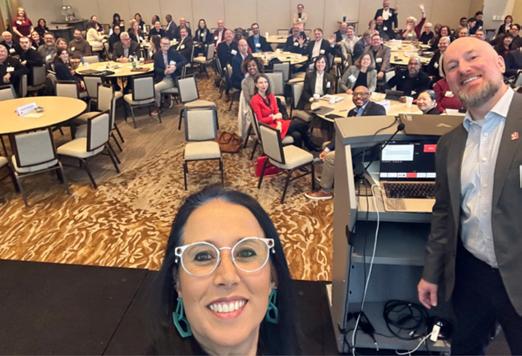
Photo Above Courtesy of Graciela Carrillo, FAIA: 2023 AIA LI Women in Architecture Event
Photo Above Courtesy of Graciela Carrillo, FAIA: 2023 AIA Strategic Council Assembly Meeting
Image Above Courtesy of Graciela Carrillo, FAIA: Immigrant Architects Coalition Podcast.
Call For Proposals
2025 AIA College of Fellows Latrobe Prize
INFORMATIONAL
The College of Fellows invites individuals and teams to submit proposals for the 2025 Latrobe Prize. Awarded to a research proposal that has the long-range potential to advance solutions to one or more significant architectural and built environment challenges, the 2025 Latrobe Prize will provide the recipient(s) with $150,000 to support a two-year program of research.

The focus of the 2025 Latrobe Prize is
Architecture's Contributions to Human Health
Proposals are sought that 1) demonstrate theoretical AND practical connections between the built environment and human health, and 2) demonstrate how architects are essential to facilitating changes to the built environment to positively affect the health of communities.
At the 2024 Annual Business Meeting, delegates overwhelmingly passed “Resolution 1: AIA Health and Wellbeing Policy”, the intent of which follows. This resolution came out of the work of the 2024 AIA Strategic Council workgroup focused on Architecture and Wellbeing.
The intent of this resolution is to increase AIA members’ value to their clients by embracing evolving knowledge and trends in health and wellbeing, by clarifying specific policies, and by promoting research-based relationships of architecture’s impact on human health and wellbeing. This is an ethical issue and requires related adjustments to AIA’s Code of Ethics and Professional Conduct plus the Framework for Design Excellence. The AIA should embrace and promote architects’ roles supporting health professionals and advocate for the incorporation of health and wellbeing-related research in architecture degree programs.
This 2025 call for Latrobe Prize proposals seeks to contribute to the members’ call and need for research focused on architecture’s impact on human health and wellbeing. While research focused on healthcare architecture is welcome, this call is in no way limited to healthcare architecture. Proposals are sought that provide evidence of Architecture’s Contributions to Human Health for any and all of the full spectrum of architecture and the built environment.
“Health is a state of complete physical, mental, and social well-being and not merely the absence of disease or infirmity.” −World Health Organization Constitution.
Call For Proposals
2025 AIA College of Fellows
Latrobe
Prize
The 2025 Latrobe Prize will be the twelfth prize, and the largest prize in its history. The College of Fellows thanks the leadership of the AIA Academy of Architecture for Health (AAH) and the American College of Healthcare Architects (ACHA) for their expertise and support in this call for proposals.
SCHEUDLE
February 19 Call for Proposals Issued (via Q1 Quarterly, AIArchitect and others)
June 30 1st Stage Proposals Due August (first week) Stage 1 Jury, (Virtual)
September 11 2nd Stage Proposals Due September 29 Stage 2 Jury, (In-Person)
October 15 Announcement of Recipient
JURY
Chair: Kirk Hamilton, FAIA, FACHA, FCCM, EDAC, Texas A&M University
Members:
Larry Scarpa, FAIA, Gold Medalist | Brooks + Scarpa, Hawthorne, California
Alison Kwok, PhD, RA, FAIA, LEED-BD+C, CPHC | University of Oregon
Jill Bergman, FAIA, FACHA, EDAC, LEED AP | HDR, San Francisco, California
Tye Farrow, FRAIC, OAA, MAIBC, Assoc AIA, LEED AP | Farrow Partners, Toronto, Canada
Kate Schwennsen, FAIA, Chancellor, AIA College of Fellows | West Des Moines, Iowa
Steven Spurlock, FAIA, LEED AP, Secretary, AIA College of Fellows | Washington, D.C.
SUBMISSION INFORMATION
Evaluation Criteria:
• Relevance of the proposed research program to the general goals and objectives of the College of Fellows, the Latrobe Prize program, and the 2025 theme.
• Breadth, depth, and innovativeness of the research program.
• Projected applications of research outcomes to practice.
• Benefits of research outcomes to professional and public constituencies.
• Qualifications, expertise, prior achievements, maturity, and performance record of the applicant(s).
• Demonstrated capacity to administer a sustained research program, including the formulation and management of the budget.
• Presence of matching funds in the proposal.
• Quality and content of supporting documentation.
• Quality and content of letters of reference.

SUBMIT HERE
https://aia.secure-platform.com/a/solicitations/408/home
For a listing of previous Latrobe Prize recipients, visit https://www.aia.org/advocacy/research/grants-fellowships/ college-of-fellows-latrobe-prize
Creating Learning Environments that Inspire and Engage Students
By Julia Eiko Hawkinson, FAIA, ALEP, LEED AP BD+C, O+M, WELL AP

Julia has been working for school districts for over 20 years to positively impact the learning experiences of the students she serves. She manages the planning of major projects transforming existing school sites and leads the effort to develop, update and align LAUSD’s design standards and educational specifications with its instructional vision. In her professional and personal efforts, Julia advocates for inspiring learning environments that provide all children the opportunity to learn, grow, and dream.
Schools may be one of the only building types that we as architects almost all have direct experience with, for most of us went to school in school buildings. What were our experiences in school? How did we relate to those buildings and more importantly how did those experiences shape who we are as architects and planners for the students of the future? When we design, we carry with us our own experiences and memories both positive and negative.
Our experiences shape who we are as designers and planners, but they also may impede our ability to listen openly to our students of today. Their needs and their experiences of the world and of school are very different than ours. Designing places that inspire students to come to school each day excited to learn begins with listening to students with an open heart and an open mind.
What happens when we listen? We learn what school experiences students find memorable, inspiring, and motivating. We learn what makes them feel that their school is for them and
is designed with their needs in mind. We learn how they value and connect with their school’s identity. We learn what makes them feel safe.
This guidance informs the creation of schools with strong sense of place and an accessible and relevant identity. All aspects of the learning environment - from the welcoming entry to the comfortable shared spaces to the inspiring classrooms - shape and influence the student experience and create a place of belonging.
We learn from students that some of their most memorable learning experiences happened outside of the traditional classroom or were connected to a specific teacher or coach. As architects, we have less impact over interpersonal experiences than we do over place-making which is our strength as designers. However, there are still opportunities to create learning environments that engage learners, beginning with identifying activities that motivate and inspire, provide

a sense of purpose, and that bring joy. These are exciting spaces to plan and design because we utilize an essential skill of architects: “Tell us what you want to do and we will design a space to do it.” This process is an exciting and rewarding aspect of the planning and design of student-centered learning environments.
Outdoor learning environments are located adjacent to classrooms to engage students in nature-based learning, active play, and environmental awareness. Landscaped school yards reflect and demonstrate native plants and ecosystems teaching students about their place in the world. Edible gardens and raised planters support interdisciplinary project-based learning opportunities integrating science, health, and geography. Flexible career technical education (CTE) spaces incorporate
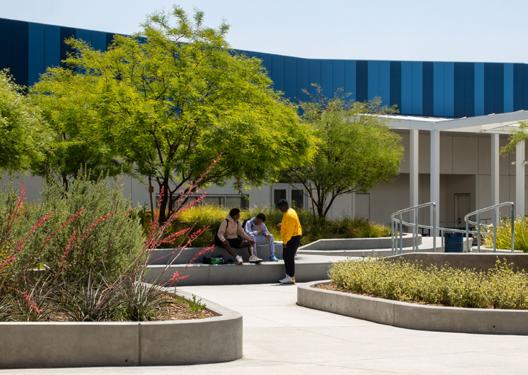
specific technical requirements to support innovative aspirations and programs, including engineering, patient care, biotechnology, sports medicine, culinary, filmmaking, esports, and gaming. CTE facilities, maker spaces, and hands-on learning labs are integrated into the campus to encourage curious students to participate. Visibility between classroom spaces and lab areas encourages collaboration, supports safety, and allows for ease of supervision. Infrastructure rich adaptable spaces allow for a variety of teaching methods and future programs. The auto shop of yesterday is transformed to include electric vehicle technology of today.
Visual and performing arts spaces support students engaged in music, visual art, dance and theater, infused with the latest technology and allowing for individual expression and collaboration across the disciplines. Art studios are designed with attention to daylight and views; music rooms are carefully planned for acoustical performance.
Special education learning environments provide facilities that are accessible to all students and are integrated into the school campus. A variety of learning spaces, ample daylight, and access to outdoor learning provides a comfortable and supportive environment for learning. Students requiring additional support are included in the daily life of their school and have convenient access to school activities.
Shared spaces for gathering including dining, performance, physical education, and libraries provide a variety of opportunities for students who prefer to be a part of large groups or to have time alone. There is a place for everyone on the school campus: one student reads on a window seat in the library, another plays an instrument in the music room, a student paints in the art classroom, another is running around
Photo Above: Roosevelt High School, Los Angeles Unified School District, Architect - LPA, Artist - Kalli Arte Photographer: Cristian Costea, Costea Photography, Inc.
Photo Above: Crenshaw High School, Los Angeles Unified School District, Architect - NAC Architecture Photographer: Michael Wells Photography

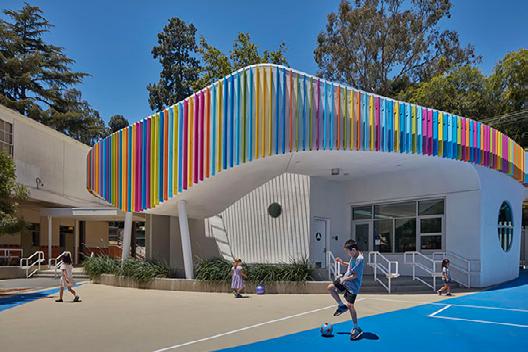

the track, and one is eating lunch and talking with a group of friends.
In the design and planning of learning environments we strive to amplify the positive student experiences and create built environments that support those experiences. Students involved in programs that inspire them are more engaged in learning. For example, students in the arts are more likely to stay in school and go to college. CTE students may find that understanding real-world challenges helps them to achieve in their academic courses. Student athletes are motivated to be physically active and healthy, but also may learn leadership, cooperation, collaboration, and people skills.
Creating places of belonging where students feel respected, safe, and inspired should guide the planning of learning environments and this is something architecture has the power to do. We provide places that show our students that they are cared about, that they are honored, and that we believe in them.
RESOURCES:
• Association for Learning Environments (A4LE) https://www.a4le.org/
• AIA Knowledge Community: Committee on Architecture for Education (CAE)
• The Impact of School Facilities on Student Learning and Engagement https://californiaschoolfacilitiesresearchinstitute. com/65-2/
Photo Above: Monroe High School, Los Angeles Unified School District, Architect - Perkins Eastman Photographer: Nils Timm
Photo above: Wonderland Elementary School, Los Angeles Unified School District, Architect- John Friedman Alice Kimm Architects Photographer: Benny Chan, fotoworks
Photo Above: Cleveland High School, Los Angeles Unified School District, Architect - PBWS Architects Photographer: Benny Chan, fotoworks
The Fellows Collection
The College is pleased to offer the following items for purchase through the AIA Design Shop!

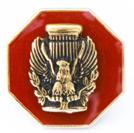
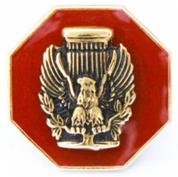
A B
A.
SMALL FAIA PIN
The small COF lapel pin measures 1/2 inch in diameter and contains 1/10 10K yellow gold.
B. LARGE FAIA PIN
The large COF lapel pin measures 5/8 inch in diameter and contains 1/10 10K yellow gold.
https://designshop.aia.org/products/collegeof-fellows-small-pin?_pos=1&_sid=66951cbed&_ ss=r&variant=16399195201

COLLEGE OF FELLOWS EARRINGS
The earrings measure 1/2 inch in diameter and contain 1/10 10K yellow gold.
https://designshop.aia.org/products/ cof-earrings?_pos=4&_sid=66951cbed&_ ss=r&variant=15331517530157

2-BALL SLEEVE WITH POKER CHIP
Perfect for gifting, each clear tube contains 2 COF Titlest TruFeel balls, and 1 COF single side resin domed Poker chip.
https://designshop.aia.org/collections/aia-items/ products/cof-2-ball-tube?variant=43164947972141

AIA COLLEGE OF FELLOWS MUG
12oz mug has natural clay variations in the base to give each piece unique artisanal character. Mug is handwash only and microwave safe.
https://designshop.aia.org/products/aia-cofmug-in-white?_pos=3&_sid=66951cbed&_ ss=r&variant=43153026908205

TRI-FOLD GOLF TOWEL
This tri-fold golf towel with our COF embroidered logo features 100% Turkish ultra-soft cotton velour.
Dimensions: 16" x 24"
https://designshop.aia.org/products/cof-trifold-golf-towel?_pos=6&_sid=66951cbed&_ ss=r&variant=43171128639533
AIA College of Fellows Executive Committee Call for Nominations
The Nominating Committee of the College of Fellows invites Candidates for the position of Secretary of the COF Executive Committee
The College of Fellows is seeking nominations for the position of Secretary. The Secretary serves a twoyear term, 2026-2027, and is one of four members of the Executive Committee governing the College of Fellows, along with the Chancellor, Vice Chancellor, and Bursar. The Secretary will typically advance to the office of Vice Chancellor and the following year to Chancellor. Consequently, election to the office of Secretary will typically result in a four-year term on the Executive Committee.
The duties of the Secretary and other members of the Executive Committee are outlined in the COF Bylaws. https://issuu.com/aiacollegeoffellows/docs/aia_cof_bylaws_2018
Any member of the College of Fellows may submit their credentials for consideration. A successful candidate will demonstrate knowledge of the activities of the College of Fellows:
• Council of Regional Representatives
• Quarterly newsletter and other communication channels
• Support of the Young Architects Forum
• Support of the College
• Investiture of Fellows and related annual Conference events
• AIA College of Fellows Component Grants
• College of Fellows Fund and associated development and fund raising
Application Packet Requirements
1. Candidate Information: Name, address, email, telephone number, year elevated to Fellowship, Object of Fellowship, and a recent portrait photograph (one page)
2. Statement of Interest: one page
3. Resumé: in outline format, including significant AIA activities and accomplishments (maximum of three pages)
4. Narrative Overview of Qualifications: Address the selection criteria and detail knowledge of COF programs and activities (maximum of two pages)
5. Letters of Reference: Provide the names and contact information of four references who are Fellows. It is the responsibility of the applicant to request letters of reference. The letters are confidential, no more than one page per letter.
The compiled, maximum 11-page application packet must be uploaded to https://aia.secure-platform. com/a/solicitations/417/home by 5pm ET, August 14, 2025.
AIA College of Fellows
Executive Committee Call for Nominations
Submissions will be reviewed by a Nominating Committee, chaired by the 2025 Vice Chancellor, Jeanne Jackson, FAIA, and include a Regional Representative of the College of Fellows, a Member-at-Large of the College of Fellows, a Former Chair of the Jury of Fellows, a Former AIA Board Member, and a representative of the Young Architects Forum.
Members of this year's Nominating Committee are:
• Jeanne Jackson, FAIA 2025 COF Vice Chancellor, Nominating Committee Chair
• Sherif Anis, FAIA COF Regional Representative
• Carl D'Silva, FAIA Former Chair of the Jury of Fellows
• Terry Brown, FAIA Former AIA Board Member
• Harry Falconer, FAIA COF Member at Large
• Tanya Kataria, AIA Representative, Young Architects Forum
The Nominating Committee will review all submissions and recommend one or more nominees for consideration by the COF Executive Committee, who, in turn, will prepare a slate of nominees for election by the members present at the virtual COF Annual Business Meeting on October 16, 2024.
Duties of the new Secretary will commence with the December 5, 2025 meeting of the Executive Committee in Washington, DC.
The following selection criteria will be applied by the Nominating Committee:
• Ability to represent and advocate for the College
• Demonstrated successful leadership in related roles
• Proven organizational and management capabilities, including fiduciary acuity
• Effective communication skills; verbal, written, and graphic
• Understanding of the mission, objectives, and initiatives of the College
• The Nominating Committee may also consider geographic location and diversity of candidates to achieve balanced representation on the Executive Committee
For more information contact Muza Conforti, Executive Director, College of Fellows, at cof@aia.org Please do not contact members of the Nominating Committee or current members of the COF Executive Committee.
Guest Contributor
What Does Your "F" Stand For?
By Richard von Luhrte, FAIA Emeritus
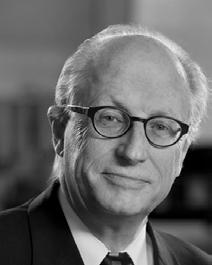
RRichard L. von Luhrte FAIA, Member Emeritus is an architect and urban designer from Colorado, where he was President of 150-person, 5 office-RNL, and responsible for creating studios in sustainability, landscape architecture, urban design and transportation. He is a graduate of the Taubman College at the University of Michigan, and advanced studies in Urban Design at the University of Colorado. He was an adjunct instructor in Pro-Practice at the University of Colorado, served on multiple Advisory Boards, and received the Distinguished Alumni award from Taubman, the Alumni Recognition Award from UCD and the AIA Denver and Colorado Architect of the Year Awards.
ecently, when setting an agenda for a Fellow’s gathering, several of us suggested that we should discuss the state of the profession, and what we can do as architects to further the 6 Objects of Fellowship. But the consensus was that the gathering should be social, justified by the “F” in FAIA standing for, F-ELLOWSHIP, F-RATERNITY, AND F-RIENDSHIP. While these are important, it seems the profession is becoming less relevant, and for me FAIA has taken on a more ominous meaning where the “F” stands for F-EAR, F-RUSTRATION and F-UTILITY. Throughout my 50 years of practice, I have seen so many missed opportunities for architects to take on leadership and engagement, with the space instead taken up by others less qualified to speak and be heard. More so today, the role of architects in advocating for a better environment and a more just society is ever more compelling, demanding us to step up and assume a soughtafter seat at the table. It is even more important that we take up the challenge as leaders to create a new paradigm of architecture, and to support a more just society, support our freedom as a country and address head-on the actual problems befalling our profession.
Guessing that I may have lost you already, here are a few specific opportunities to shift the conversation to a more purposeful, problem-solving agenda that directly and indirectly addresses the F-UTILITY of a profession that is losing relevancy and respect.
CLIMATE CHANGE:
Climate change should not be political, though it has been made so by a population viewing anything related to climate to be F-AKE and F-OOLHARDY, with every program and commitment to climate disaster mitigation marginalized.
For architects, sustainability has become a lynchpin of our beliefs. But because of our often-weak implementation of these beliefs, our efforts are generally benign in the larger perspective of climate mitigation. With 40% of the entire carbon footprint caused by building there is a tremendous opportunity for architects to be bold in reaching a net zero future and in filling the void of climate leadership. We should commit to designing only sustainable projects, to only use sustainable building products, and to promote change in local and state codes and regulations for sustainability. We can educate the public (our clients) as to the importance of solutions for a warming planet. We can design with reduced dependency of fossil-fuel energy, and specify new net- positive materials we help develop.
As Fellows we should speak loudly and make our “F” become the visible “F-IREBRAND” for the environmental movement, and to counter the despondency of the nay-sayers. This must become our primary initiative for reforming the built environment to a more sustainable future.
NATURAL DISASTERS:
Today we are experiencing ever increasing and more catastrophic natural disasters, made worse by the net effect of climate change and bad planning. But our nation is beginning to question the viability of relief from disasters with subsidy or insurance, looking by necessity to more proactive solutions so that society does not keep making the same mistakes again and again.
Natural disasters can be moderated with appropriate land use policies, better building codes, and appropriate design to context and place. Architects can redesign our cities to be more resilient to wildfires, less impacted by hurricanes and floods, all reducing the impact. Building codes can be rewritten to mandate fireproof and windproof construction, and zoning can be re-written to avoid sprawl, avoid fragile land, and reduce building in the urban/wild interface. Density done right can be made desirable for reducing the urban footprint.
Fellows can lead this charge to a more resilient built environment capable of withstanding the impacts of the everincreasing loss of life and cost impacts of natural disasters.
LOSS OF PROFESSIONAL STANDING:
We are a nation run by laws; lawyers are everywhere. This results in a legal framework that is not necessarily the best answer for building in a changing world. Whether it is affordability, sustainability, or where, what and how to build, we are driven by laws and regulations that create “red tape” to limit changes needed to solve new challenges. I have long believed that the “hero’s” of the profession, who step outside their comfort zone to become involved in law-making are elected officials, members of boards or commissions, or as advocates for legislation that supports the objectives of good design.
Architecture is uniquely the only profession driven in service to the public to preserve the “Health, Safety, and Welfare” of the built environment. Architects were once seen as the most ethical, noble and well respected of the professions. We have for the most part obviated this responsibility by becoming more the victim rather than the victor! Rather than being the author of solutions, the architect has become the product of demands by others. Other professions have taken the leadership in building where architects have relinquished our position. We have become enslaved by technology, reinforcing formulistic design that repeats the mistakes of the past.
The F-EAR and F-RUSTRATION of my “F” is that ultimately, we lose our independence, that we become irrelevant in the design process, subservient to others, replaced by AI, and lose our right of license to allow anybody to claim our role. If we care about our future right to practice, this should become a rallying cry to become more relevant as leaders in building.
THE SCIENCE OF ARCHITECTURE:
There was an interesting debate in the AIA Fellows Forum last month whether architecture is an art or a science. Many architects would want architecture to be first and foremost an artform, but we also know that architecture is founded on definable scientific principles of structure, systems, and comforts. My “F” F-EARS that AIA has contributed to the schism by giving awards and accolades to “Starchitects” who create the grand buildings that are statements of ego, power and wealth. While there is nothing wrong with doing grand buildings, there is risk that we become branded as oblivious to function and to health, safety and welfare.
Architects touch only a small portion of the built environment and even less of all housing. This is just not sustainable for the profession nor helpful to our reputation. We must use our ‘F” as a calling card for transforming architecture as it should be practiced, celebrating more than form, but also the science of building and the solving of problems of resilience, sustainability, efficiency affordability and purpose.
EDUCATION:
There just is not enough time in the architectural curriculum to learn all the complexities of the profession. This often results in emphasizing form rather than the complexity of both function and substance that feeds architecture as object, not as place. Where student achievement is judged primarily in studio, architectural education can ignore avenues of talent and excellence where students could find purpose and success in other pursuits within the profession. Education also often does not promote architecture as a “team sport”. If education teaches a “master-builder” approach, the graduate is much less likely to recognize the talents of the team and the contributions that all disciplines can make in achieving great design. Teamwork promotes better solutions and gives everyone involved a chance to grow and contribute, thus increasing satisfaction and achievement.
The AIA has the responsibility to work with educators to create an architectural education that is accessible to everyone who shows interest. There is a need for teaching equity, and to fight against elitism in design only for the few. Students deserve the knowledge and expertise of practiced professionals who can bring a world view of decision making, politics, and economics, and can put into perspective the balance between form and function.
The AIA Fellow has the responsibility to be a mentor to young people to pass along our experience and F-RAMEWORK and F-OUNDATION for design process, and to instill the values of service and stewardship and teamwork. The Fellow must become involved in educational reform by serving on advisory boards, by supporting accreditation, and by teaching at all levels both in class and in continuing education.
POLITICS:
If written 6 months ago, it would be less obvious as to why architects need to engage in political discourse. But as a recent embodiment of our eroding freedoms, the mandate that all public architecture be designed in a classical style might seem rather insignificant in the larger morass of misdirected public policy. In a larger sense, work is being taken away, grants are being canceled, research is being eliminated. Racism is cropping up in legislation, books are banned, and the academic freedom of education is being challenged. With the elimination of thousands of jobs, public buildings are being vacated and sold, agencies of service eliminated, and we are being told what to say regarding sustainability and health. All in all, this translates into more unrest, and greater disfunction of society, and polarization of our citizenry.
I realize that there are respected Fellows who would not agree about threats to F-REEDOM but we are not in normal times where consensus can be achieved through dialogue and compromise and where commissions are granted based on merit, not patronage or favoritism. Looking at the plight of our citizens and our communities, architects can be in the center of the discussion. A dysfunctional government directly affects what we build, where we build, and how we build. Architecture is in many ways is the barometer of contentment and comfort. When public happiness and the economy is strong, well-being is positive and cities thrive.
Irrespective of our own political beliefs, engagement politically is critical to the profession and ultimately to the future of our nation. Our voice can be heard in areas of expertise that are uniquely ours. Whether it be crime in deteriorated downtowns, design for the elderly and physically challenged, the preservation of our history, or the design of defensible space, solutions need to be found for a more equitable society. To do this, politics must be a part of that discussion. As a heretofore silent profession, we need to speak up! If we don’t, we can’t whine when we are summarily discounted, and we can’t complain when the issues of the built environment are ignored. It is critical that we use our experience and talents to create the kind of nation that is not F-EARFUL and F-RAGILE, but rather secure, comfortable, and confidently moving forward.
It is critically important that we enter this nasty world of politics with a strong voice of fairness and respect for everyone, and for a government that while flawed, is about the people. This is our ultimate “Health, Safety and Welfare” role, and our opportunity to contribute positively for a more egalitarian governance that supports and endorses the beliefs that we hold dear.
THE BOTTOM LINE:
There is a role for the Fellows of AIA who believe their “F” is F-RAGILE and F-RAIL, to take up the leadership that has been earned from years of experience, to motivate and engage the profession and to be the voice for change that will both provide a new avenue for architects to be visible and respected, while providing problem solving and consensus building that is the earmark of our professional education and practice. In our role as leaders of the profession, we must undertake these challenges, and motivate the changes that need to be made, whether it be to the body-politic who sets the rules, to the public that lives those rules, to the clients who must be brought along, or to the next generation of architects, who are the future in solving problems in a meaningful way.
Do this, and the result will be that our “F” can indeed be F-ORTUNATE , for anyone who has decided to be an architect and for everyone who sets foot within a building!
Alleviating Phoenix’s Affordable Housing Crisis through
Collaboration, Mentorship, and Competition
2024 COF Component Grant Recipient
AIA Arizona
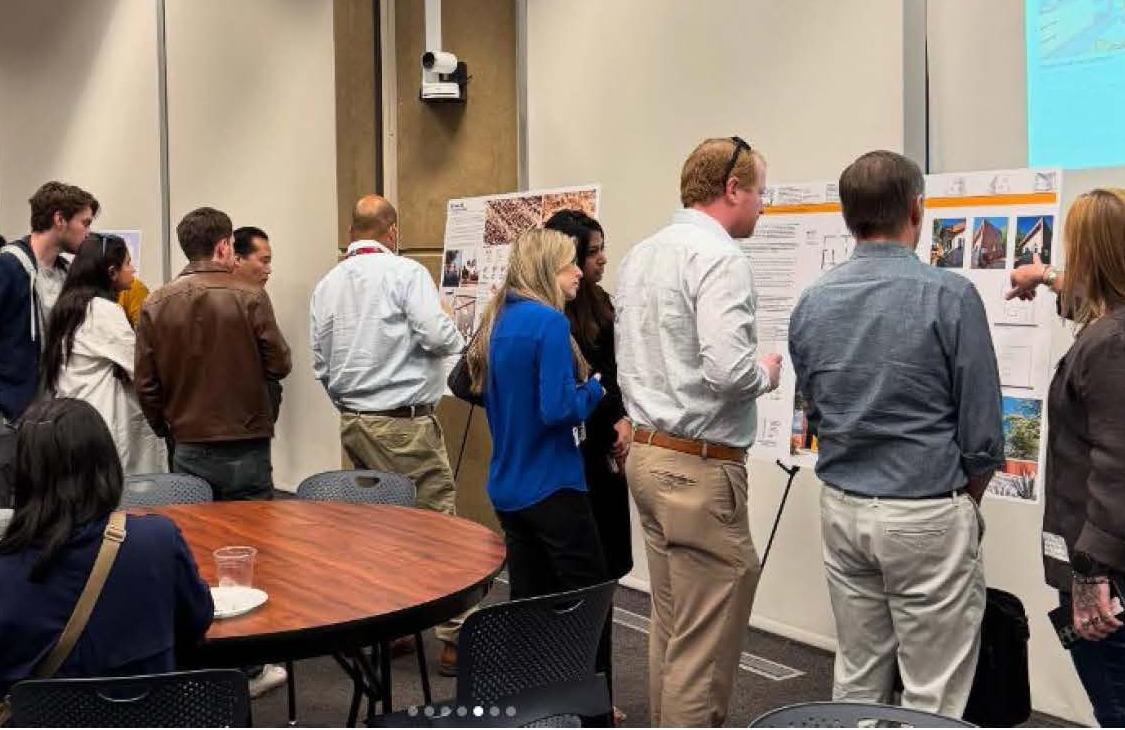
The 2024 AIA College of Fellows Component Grant funded a design competition held in collaboration with the City of Phoenix to jumpstart a curated collection for an ADU (Accessory Dwelling Unit) pre-approved standard plans library. The competition was designed to address the housing crisis in the City of Phoenix.
STAKEHOLDER COLLABORATION
The Competition Committee was comprised of AIA Phoenix Metro Members along with staff from the City of Phoenix Planning and Development Department. The regular committee meetings, along with a shared goal of creating a more affordable housing option helped to strengthen the relationship between our architect members, as well as the local AIA Chapter with the City of Phoenix.
PARTICIPATION
The competition gained the attention of teams in multiple states including AIA members, other design professionals and students. 62 teams registered, with 48 team submitting their designs. The competition jury included both the City of Phoenix Mayor and Vice Mayor, along with an Arizona State Senator furthering the goal of elevating the role architects play in designing a resilient infrastructure in the nation’s 6th largest city.
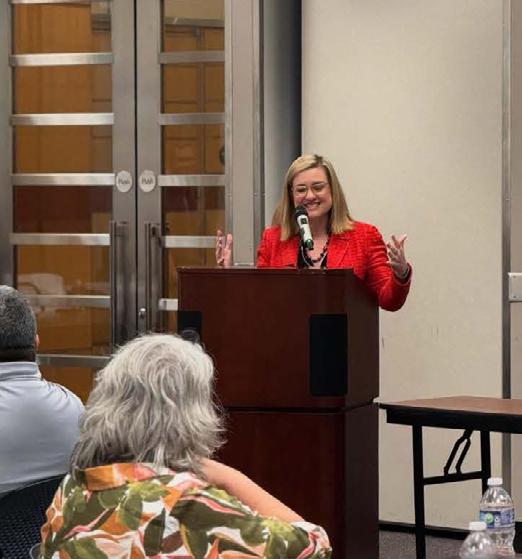
Photo Above: City of Phoenix Mayor Kate Gallego speaks to attendees.
Competition Jury:
Mayor Kate Gallego, City of Phoenix
Vice Mayor Debra Stark, City of Phoenix
Senator Anna Hernandez, Arizona State Senate
Jared Basler, Casita Coalition
Zachary Burns, Steel + Spark
Caroline Lobo, AIA, suoLL architects
Lorenzo Perez, Venue Projects
Deirdre Pfeiffer, Arizona State University
USE OF FUNDS
Grant funds were used for cash prizes to the competition finalists. A total of $10,000 was awarded. The AIA Phoenix Metro Chapter supplemented the awards as well as funding refreshments during jury deliberations, lunch for the awards celebration held at Phoenix City Hall and a travel stipend for one out of town jury member from the Casita Coalition out of Los Angeles, CA.
PROGRAM ACTIVITIES
Jury Deliberations – October 29, 2024
Finalist Notified – November 5, 2024
Awards Celebration – December 3, 2024 City of Phoenix Jury – January 2025
OUTCOMES AND IMPACTS
Four teams received a $2000 prize: Winner for Big Idea Winner for Tiny Home Winner for Aging in Place Best Overall
Two teams received a $1000 runner up prize
Two teams received an Honorable Mention
Boards for the winning designs will be on display in Phoenix City Hall through the first quarter of 2025.
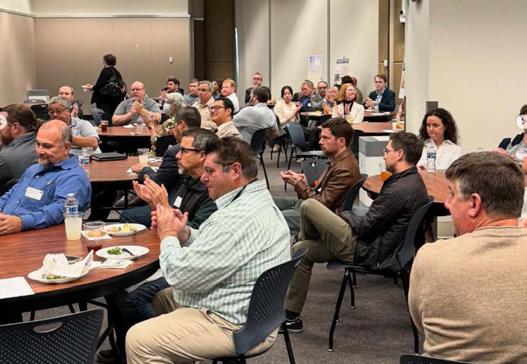

An article about the competition and winners will be featured in an upcoming edition of Sources for Design (sourcesfordesign.com), an online publication for Arizona’s design-build community. We will forward a copy once published.
All competition submittals will be posted to the competition website at https://aia-phoenixmetro.org/
FUTURE PLANS
Step two in the competition is another jury process with the City of Phoenix Planning and Development Department. City staff, along AIA members on the committee will once again review all the submittals determining which designs best represent practical materials, adaptability and affordability. Up to four teams will receive an additional $20,000 to develop a full set of plans for their design.
Help make programs like this possible by donating or honoring someone with a gift to the College of Fellows Fund today!

Photo Above: Attendees
Photo Below: City of Phoenix Mayor Kate Gallego speaks to attendees.
THE HERITAGE SOCIETY OF THE AIA COLLEGE OF FELLOWS
WhatwillyourLegacybe?
The primary purpose of the Society is to formally recognize those individuals who have demonstrated a life-long commitment to the mission and programs of the AIA College of Fellows with a revocable estate bequest.
By virtue of having included a commitment in their estate plan of a bequest for the future benefit of the College and its programs, the following distinguished individuals are the Members of the Heritage Society of the AIA College of Fellows:
Joseph A. Boggs, FAIA
Ellis W. Bullock, FAIA
John A. Busby, Jr., FAIA
Donald Wesley Caskey, FAIA
John Castellana, FAIA
William David Chilton, FAIA
Betsey Olenick Dougherty, FAIA
Brian Paul Dougherty, FAIA
Harry M. Falconer, Jr., FAIA
Dr. Robert Allen Findlay, FAIA
L. Jane Hastings, FAIA*
Russell V. Keune, FAIA
Ed Kodet, FAIA
Lisa Lamkin, FAIA
Howarth L. Lewis, Jr., FAIA
Ivenue Love-Stanley, FAIA
Frank Lucas, FAIA*
Robert Ooley, FAIA
Burton L. Roslyn, FAIA
Jeffrey Scherer, FAIA
Roger L. Schluntz, FAIA
John Sorrenti, FAIA
Steven Spurlock, FAIA
William J. Stanley, III, FAIA
Ed Vance, RA
William F. Vosbeck, FAIA
Membership in the Society is conferred upon formal notification to the College of a planned estate gift with a minimum value of $10,000.
We cordially invite you to undertake a similar, revocable, commitment in your estate plan, and thereby becoming a member of the Heritage Society. It’s simple to accomplish and it costs nothing!
With additional Members the future support of our programs and long-term viability of the College will be substantially enhanced and extended well into the future. For additional information and application, please contact Muza Conforti, cof@aia.org.
*Denotes a deceased member.
Regional Representative Message
By Stuart Pettitt, FAIA

Your Regional Representatives have been busy this year with lots of energy displayed on our recent virtual call with 13 of the 15 enthusiastic new Regional Reps introducing themselves. A couple critical issues were discussed.
With the recent class of 2025 Fellows announced, some wondered what is being done to mentor and advise potential Fellows. As was discovered some Regions/States have highly active Fellows Committees and some do not at all.
The Regional Reps will follow up with further discussions and meeting presentations hopefully with the with the active Regional Reps explaining to the others some of their inspirations, strategies, and methodologies. It might even be possible to have Fellows Committees mentor potential candidates across Region boundaries with all the virtual communication possibilities. If you would like to get involved, please contact your Regional Rep to volunteer. The Regional Representative contact information is available in the Regional Representative Welcome Packet that can be found in our publications on Issuu: https://issuu.com/aiacollegeoffellows/ docs/2025_regional_representative_welcome_packet
If anyone is interested in learning about mentoring young Architects, please sign up for the EV151 ”The Young Architects Forum: Bridging Generations” session at AIA25 in Boston on 6/7/25 at 1:00pm. These young Architects would love to hear your stories of your career trajectories.
For the second issue, we discussed fundraising for the Fellows Fund. We have not been as successful as we could have been or should have been over the past couple of years. We will follow up with a meeting agenda focusing on Fundraising strategies, opportunities, techniques, schedules, etc. In 2024, only 9% of all Fellows contributed to the Fellows Fund. I am not sure why this is not 100%, but certainly we can do much better.
Your Regional Representative will probably reach out to you much earlier this year to encourage your participation in supporting the College of Fellows’ goals and aspirations. As you know, the Fellows Fund supports critical programs for our architectural profession, including mentoring young architects and emerging professionals, promoting and supporting research, and sustaining the College of Fellows. Particularly important is our mentoring and support for the emerging architects who will soon lead our profession. If you would like to donate now, go to the AIA website under College of Fellows or click here: https://cof.networkforgood.com/
Thanks!
Stuart Pettit, FAIA Regional Representative Chair




Feature | AIA Young Architects Forum
Interviewing an Icon: Two Hours with Denise Scott Brown, Hon. FAIA
By Caitlin Brady, AIA
Previously published in YAF Connection Q1-2025
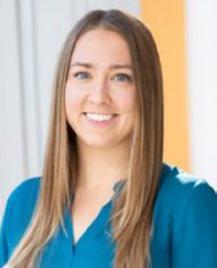
Denise Scott Brown is an architect; planner & urban designer; and a theorist, writer and educator whose projects, research, and writing have influenced designers and architects since the 1960s. Her writings have changed the practice of architecture as we know it and her built work spans several continents. Some of her notable writings include Learning from Las Vegas, Having Words, and Architecture as Signs and Systems. She was a long-standing principal of the firm Venturi, Scott Brown and Associates.
Nobody is more enthusiastic about Philadelphia architecture than those who have graduated from an architecture program in Philadelphia. We gleefully navigate William Penn’s gridded urban plan, delightfully sketch the details of Frank Furness’ buildings, and reverently observe the play of light and shadow in Louis Kahn’s works.
These legends all seemed firmly rooted in the past. I never expected to end up on a Zoom call with one of Philadelphia’s most notable industry icons. But in January 2023, I was logging on for an interview with 92-year-old Denise Scott Brown.
Denise Scott Brown is an architect; planner and urban designer; and a theorist, writer and educator whose projects, research, and writing have influenced designers and architects since the 1960s. Her writings changed the practice of architecture as we know it. Her notable writings include Learning from Las Vegas, Having Words, and Architecture as Signs and Systems. She
was also a long-time principal of the firm Venturi, Scott Brown and Associates.
How did I get here? It all started in 2022. I had left San Francisco and was working remotely for a new company while traveling across the country and I missed the connection of a local AIA community. I had been scheduling “coffee dates” with my colleagues to get to know them better and these conversations sparked an idea. What if I recorded these chats and shared them with others?
The Architectette Podcast was born. Every other Monday, we share an interview with a guest to highlight their unique stories and experiences as women in architecture, design, engineering, and construction. Why? Although women graduate at equal or greater rates as men, they still struggle for representation in leadership (especially at big firms). I founded the podcast to encourage and inspire more women to become licensed architects, promoted to leadership positions, and champion equality and inclusion.
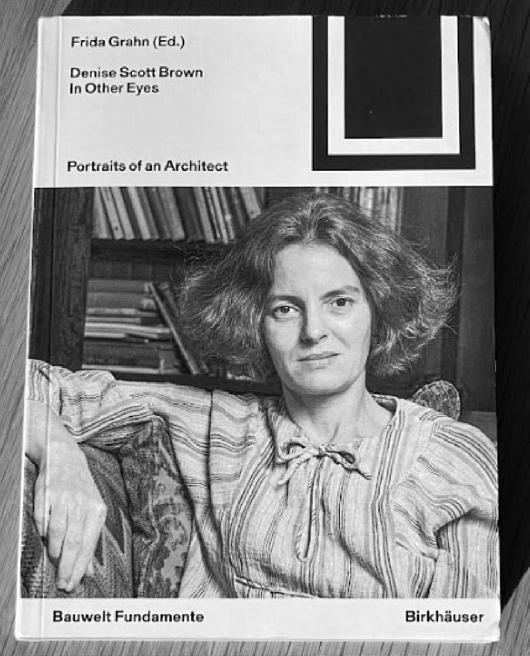
Back to Denise. I had cold-emailed her team in late 2023 and was thrilled when she was interested in being a guest on the podcast. I sent over an initial list of questions. Her team responded: “[...] some of her existing articles and publications would answer some of the questions you posed. [We] recommend that you read some of the newer literature on her to make questions that are a bit more targeted [...].” Yikes!
I needed to dive deeper. This wasn’t a typical Architectette interview, Denise had decades of work to discuss (seriously, check out her bibliography on her website). For weeks, I poured over her publications, listened to past lectures and interviews, read research papers, listened to other podcasts, and read Frida Grahn’s Denise Scott Brown In Other Eyes: Portrait of an Architect.
I compiled several rounds of revisions. I restructured the interview; I wanted our conversation to explore Denise’s humanity in tandem with her accomplishments.
Our conversation ran over 2.5 hours. I tried to maintain my cool as we discussed the origin stories of "duck vs decorated shed" and chatted about Denise’s concept for and staging of the iconic photos of Denise and Robert Venturi in front of the Las Vegas strip. It was a thrilling experience to read about Denise’s work in a textbook, knowing I could later ask her to clarify or elaborate.
We talked about her development as a theorist, career highlights, and notable projects; but I was thrilled when she candidly discussed more personal topics- those that aren’t covered in books. Denise shared about the influence of her early childhood memories, the challenges and joys of balancing her role as practitioner and mother, and her experience as a woman who was sometimes cast into the shadow of her partner, Robert Venturi. We laughed, we cried, and I was awestruck by Denise’s candor and outstanding memory.
As her long career illustrates, one never runs out of work when you are fascinated by all that surrounds you. Denise taught me to think deeply, to appreciate details, and to lead with curiosity and empathy. As we wrapped up, I asked Denise what she is currently working on and she responded: “You!” Even in her nineties, she continues to encourage emerging leaders in the design industry to follow in her footsteps to bring good into this world whether it’s through advocacy, design, or action.
We aired the interview, divided into two episodes, in May 2024 to delightfully positive feedback. The two-part episode can be found at https://www.architectette.com/episodes/denisescott-brown-1
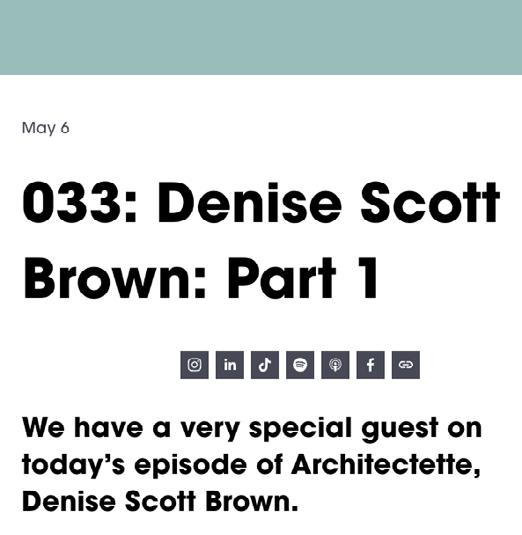
Check out more from the Young Architects Forum at https://issuu.com/youngarchitectsforum
Bio:
Caitlin Brady AIA, LEED AP BD+C is an Associate and Project Architect at Ayers Saint Gross in Washington, D.C. Brady has been recognized with the 2023 AIA|DC Emerging Architect Award and currently hosts the podcast, Architectette.
Author
AIA's New Global Campus for Architecture & Design: Construction Progress Update and Sustainability Initiatives

By Stephen T. Ayers, FAIA
Interim Executive Vice President and CEO
As the American Institute of Architects (AIA) continues to lead the profession toward a more sustainable and equitable built environment, the transformation of its headquarters in Washington, D.C., stands as a paragon of these aspirations. The new AIA Global Campus for Architecture & Design project is not just a renovation; it is a reinvention, rooted in the values of sustainability, inclusion, and design excellence.
The 1970s building in Washington, D.C., located at 1735 New York Avenue NW, is being reimagined into a modern, high-performing, and welcoming space that embodies AIA’s commitment to climate action and social responsibility. This pivotal project, expected to be completed in late 2025, will serve as a living laboratory for the community and profession—a place where innovation, stewardship, and collaboration converge. The new design preserves the iconic, brutalist façade while dramatically transforming the interior into a light-filled, adaptable environment. A central mass timber stair will connect the first three levels, creating opportunities for interaction, collaboration, and events.
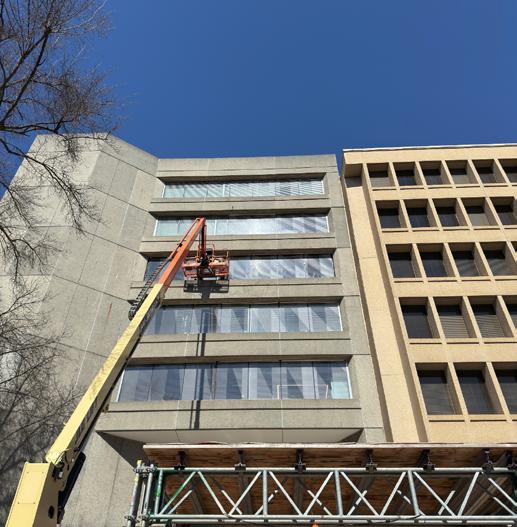
Photo Above Courtesy of David Sidell: Exterior Renovations
PROJECT PROGRESS
AIA engaged numerous expert vendors to realize this vision, including EHDD Architecture, based in San Francisco, CA, in collaboration with Hartman Cox Architecture for local administration; Hood Design Studio for landscape design; Cresa Project Management as the owner’s representative; Turner Construction as the general contractor; and a robust team of sustainability and engineering consultants. Construction officially began in late 2023, following a rigorous and collaborative planning process that engaged AIA members, staff, consultants, and community stakeholders. The project is progressing well and has completed the following key milestones:
• Completion of all major demolition and hazmat abatement phases
• Installation of cistern tanks to support a grey water system
• Installation of all-new glazing to improve the building envelope’s energy efficiency
• Structural upgrades to improve accessibility and spatial flexibility
• Completion of the air to water heat exchanger installation
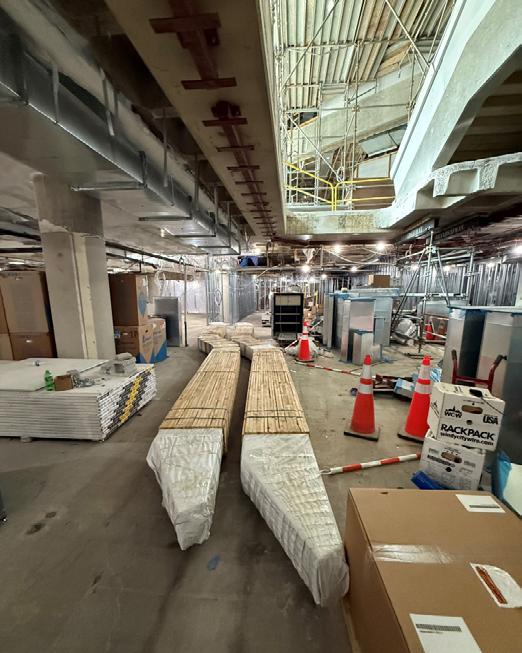

SUSTAINABILITY
From its inception, the new AIA Global Campus for Architecture & Design has aimed to set a new standard for environmental performance. The design is pursuing both LEED Platinum and WELL Platinum design certifications as well as adherence to the AIA Framework for Design Excellence. A priority is to achieve net-zero carbon—a milestone that reflects both AIA’s 2030 Commitment and the larger imperative to lead the built environment by example.
Sustainability features include:
• Mass timber construction: Selective use of glulam mass timber for the monumental stair stringers helps reduce embodied carbon and adds warmth to interior spaces.
• Daylighting and views: Generous glazing, solar shading, and light wells ensure that natural light reaches deep into the building.
• Biophilic design: Landscape elements, green roofs, indoor plantings, and nature-mimicking design features enhance occupant well-being and connect the building to its urban context.
• Material transparency: Low-VOC, low-carbon, responsibly sourced, and healthy building materials have been prioritized throughout.
• Solar power generation: Solar panel arrays are designed for the rooftop as part of an REC swap as well as on the new façade shade structure. This solar initiative also provides $500,000 for Habitat for Humanity to install solar panels on homes they build in the community.
• Total electrification: the building has been retrofitted with electric water heaters and pumps in lieu of the gas-
Photo Above Courtesy of David Sidell: New connection from first floor to lower level.
Photo Above Courtesy of David Sidell: Stringers for new connection between first floor and lower level.

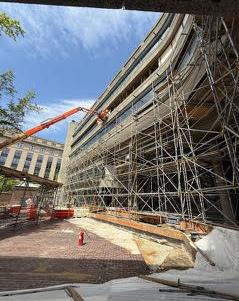

fired boilers, further reducing the carbon footprint.
The new AIA Global Campus for Architecture & Design is more than an office building; it is a demonstration project for the architectural community. It embodies the principles that AIA has long championed: design excellence, ethical leadership, and service to society. Through this transformation, AIA is creating a space that reflects the profession’s highest ideals— while serving as an educational tool, convening hub, and source of inspiration for future generations.
As it moves toward completion, AIA invites its members to engage with the project—through virtual or in-person tours, educational resources, and future events that will celebrate this new chapter in our collective story.
Together, we are building more than a headquarters. We are building a legacy.
Photo Above Courtesy of David Sidell: Exterior facade renovation.
Photo Above Courtesy of David Sidell: Main lobby entry will now be the entry for the AIA Store, directly off of New York Avenue.
Photo Below Courtesy of David Sidell: Graywater storage tanks arriving for installation in the lower level parking garage.
2025
Fellows Remembered
David M. Childs, FAIA
Barbara (Bobbie) Goldberg Neski, FAIA
John Edward Mahlum, FAIA
Raymond ("Skipper") George Post, Jr. FAIA
Danie Johnson, FAIA
Ronald Gene Brown, FAIA
David E. Sellers, FAIA
James R. Grieves, FAIA
Dean Bahr, FAIA
Robert Stanley George, FAIA
Gretchen K. Pfaehler, FAIA
2024
Freidrich St. Florian, FAIA
Yoshio Taniguchi, FAIA
David E. Lawson, FAIA
Curtis J. Moody, FAIA
Roger K. Lewis, FAIA
Henry G. Meier, FAIA
John Q. Lawson, FAIA
James Gatch, FAIA
Howard Backen, FAIA
Chiu Tse-Chan, FAIA
Ronald Wommack, FAIA
Stan Boles, FAIA
Michael Watson, FAIA
Wayne S. Schmidt, FAIA
Aric Lasher, FAIA
Charles "Chuck" Schwing, FAIA
Doris Danna, FAIA
Benjamin H. Weese, FAIA
Tom Posedly, FAIA
Leonard S. Wicklund, FAIA
L. Jane Hastings, FAIA
Lee Hahnfeld, FAIA
Frank Hope, III, FAIA
Charles E. Dagnit, Jr. FAIA
David Body, FAIA
Harry Kennard Bussard, FAIA
George W. Acock, FAIA
Ryamond Grenald, FAIA
Antione Predock, FAIA
Roscoe Reeves, Jr. FAIA
David Holtz, FAIA
Clyde Warner, FAIA
Marsha Maytum, FAIA
John W. Weekes FAIA
William N. Larson, FAIA
H. Carelton Godsey, Jr, FAIA
Les Tincknell, FAIA
C. Robert Campbell, FAIA
I. Donald Weston, FAIA
Emanuel Kelly, FAIA
Dwight E. Holmes, FAIA
Legacy Donors of the
AIA College of Fellows
LEGACY DONORS
($10,000 and above cumulative donations)
New 2024 Legacy Members shown in Bold Face
LEGACY 50
($50,000 and above)
Frank E. Lucas, FAIA*
LEGACY 40
($40,000-$49,999)
L. Jane Hastings, FAIA*
Jeanne Jackson, FAIA
Edward J. Kodet Jr., FAIA
Victor A. Regnier, FAIA
Roger Schluntz, FAIA
LEGACY 30
($30,000-$39,999)
Harold L. Adams, FAIA
S. A. Klatskin, FAIA
John R. Klai II, FAIA*
Peter P. Marino, FAIA
Donald E. Neptune, FAIA
Robert L. Ooley, FAIA
Ronald L. Skaggs, FAIA
Joseph G. Sprague, FAIA
John Sorrenti, FAIA
Steven L. Spurlock, FAIA
LEGACY 20
($20,000-$29,999)
Betsey Olenick Dougherty, FAIA
Brian P. Dougherty, FAIA
Donald J. Hackl, FAIA
Ivenue Love-Stanley, FAIA
Lenore M. Lucey, FAIA
Robert A. Odermatt, FAIA
Ted P. Pappas, FAIA
William J. Stanley, FAIA
William F. Vosbeck, FAIA
LEGACY 10
($10,000-$19,999)
Ronald A. Altoon, FAIA
Louis D. Astorino, FAIA
Paul H. Barkley, FAIA
Sigmund F. Blum, FAIA*
Joseph Boggs, FAIA
Ellis W. Bullock, FAIA
John A. Busby Jr., FAIA
Donald W. Caskey, FAIA
John J. Castellana, FAIA
William D. Chilton, FAIA
Gary B. Coursey, FAIA
Sylvester Damianos, FAIA
William A. Edgerton, FAIA
Michael Enomoto, FAIA
Thomas B. Gerfen, FAIA
Debra Gerod, FAIA
Manuel G. Gonzalez, FAIA
Graham Gund, FAIA
Daniel Hart, FAIA
John F. Hartray Jr., FAIA
Russell V. Keune, FAIA
Stephen J. Kieran, FAIA
Peter G. Kuttner, FAIA
Norman L. Koonce, FAIA
Carroll J. Lawler, FAIA
Lawrence J. Leis, FAIA
Rev. Howarth L. Lewis, FAIA
Paula J. Loomis, FAIA
Steven Loomis, FAIA
William Mahan, FAIA
Marvin J. Malecha, FAIA
Clark D. Manus, FAIA
Judsen R. Marquardt, FAIA
George H. Miller, FAIA
Amy Miller Dowell, FAIA
John Pearce, FAIA
Thompson E. Penney, FAIA
Raymond G. Post Jr., FAIA*
William A. Rose Jr., FAIA*
Burton Roslyn, FAIA
Albert W. Rubeling Jr., FAIA
Harry Rutledge, FAIA
John A. Ruffo, FAIA
Jeffrey A. Scherer, FAIA
Bruce Sekanick, FAIA
Robert I. Selby, FAIA
Jim M. Singleton IV, FAIA
Kalavati Somvanshi, FAIA
Jonathan Sparer, FAIA
Douglas L. Steidl, FAIA
RK Stewart, FAIA
Kim M. Tanzer, FAIA
James D. Tittle, FAIA
Edward T. M. Tsoi, FAIA
Edward A. Vance, RA
R. Randall Vosbeck, FAIA
Chester A. Widom, FAIA
Douglas Wignall, FAIA
Joseph J. Wisnewski, FAIA
F.M. Wong, FAIA
Enrique A. Woodroffe, FAIA
Hofu Wu, FAIA
Raymond Ziegler, FAIA
Contributors to the College of Fellows Fund 2024 Calendar Year
The AIA College of Fellows is grateful to everyone who contributed in 2024 to support the College of Fellows Fund. Your generosity is genuinely appreciated. Your gifts are extremely important to the College as they allow us to continue and increase support for our Mission and three primary Goals:
• Promote Research and Scholarly Work
• Mentor Young Architects and Emerging Professionals
• Sustain the College
On behalf of those who benefit from your donations, especially those who will become Fellows and the AIA leaders of tomorrow, the College of Fellows Executive Committee and all Fellows thank you for your generous donations!
Kate Schwennsen, FAIA 2025 Chancellor
ANNUAL DONATIONS IN 2024
(Contributions of $1,000 or more shown in BOLD FACE)
ARIZONA
Henry Tom
CALIFORNIA
Glenn Bauer
Gordon Chong
Andrew Cupples
Samuel D'Amico
Betsey Dougherty
Brian Dougherty
Stuart Eckblad
Michael Enomoto
Eric Haesloop
Richard Heinz
William Mahan
Frederick Marks
Joyce Polhamus
Victor Regnier
Lee Salin
James Spencer
Joel Tomei
William Valentine
Francis Zwart
COLORADO
Sarah Broughton
Blake Chambliss
Albert Davis
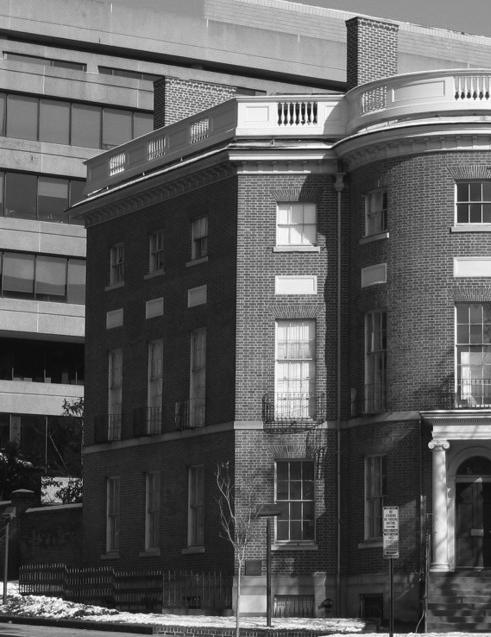
Gary Desmond
Gregory Friesen
Alan G. Gass
Andrew Nielsen
Sarah Semple Brown
R Randall Vosbeck
CONNECTICUT
F. Michael Ayles
Phillip Bernstein
Gina Calabro
Jonathan Humble
DISTRICT OF COLUMBIA
Anthony Barnes
William Bonstra
Yolanda Cole
David Haresign
Jonathan Herz
David Insinga
Constance Lai
Lenore Lucey
Chris Morrison
John Pearce
Jonathan Penndorf
Andrew Pressman
Brenda Sanchez
Sean Stadler
Steven Spurlock
James Voelzke
FLORIDA
Gregory Burke
Nathan Butler
Charles Clary
Jacquelyn Hale
Bill Hercules
David Metzger
Marilys Nepomechie
Clemens Schaub
Joseph Valerio
HAWAII
John Ida
Carol Sakata
IDAHO
Jack Smith
ILLINOIS
Martha Bell
Jeff Bone
Joseph Burns
Jane Cameron
Joseph Caprile
Philip Castillo
David M. Chasso
Dave Eckmann
Rand Ekman
Jeanne Gang
Holly Gerberding
David Hovey
Helen Kessler
Nathan Kipnis
Lawrence Livergood
Paul O'Shea
Dawn Schuette
Mark Schwamel
Gracia Shiffrin
Jonathan Solomon
John Syvertsen
Grant Uhlir
Peter Weismantle
INDIANA
Steve Alspaugh
Sanford Garner
Lisa Gomperts
Dean Illingworth
Jonathan Spodek
Drew White
Contributors to the College of Fellows Fund 2024 Calendar Year
IOWA
Rod Kruse
Tim Schroeder
Kate Schwennsen
KANSAS
Robert Condia
Wendy Ornelas
KENTUCKY
Randall Vaughn
LOUISIANA
Ronald Blitch
Creed Brierre
Raymond Post*
MASSACHUSETTS
Janette Blackburn
Jean Carroon
Philip Chen
Emily Grandstaff-Rice
Margo Jones
Thomas Kearns
Peter Kuttner
Britt Lindberg
John Martin
Louis Sirianni
Peter Vieira
MARYLAND
Lance Davis
Kathleen Lechleiter
Tom Liebel
Janet Pogue McLaurin
Joseph Ruocco
Kevin Sneed
Karl Stumpf
MICHIGAN
John Allegretti
James Chaffers
Alan Cobb
Brian Craig

Jan Culbertson
Michael Guthrie
Douglas Hanna
Eric Hill
Gene Hopkins
Brian Hurttienne
Dennis King
Elisabeth Knibbe
Bryan Lijewski
Saundra Little
Thomas Mathison
Michael Neville
J. Stuart Pettitt
Victor Saroki
Gary Skog
Benedetto Tiseo
Stephen Vogel
Robert Ziegelman
Dawn Zuber
MINNESOTA
Stephen Fiskum
Tom Hysell
Edward Kodet
Rosemary McMonigal
Julia Robinson
Bruce Wright
MISSOURI
Karl Grice
MISSISSIPPI
Anne Decker
Roy Decker
NORTH CAROLINA
J Richard Alsop
Charles Boney
Benjamin Cahoon
Teri Canada
Heister Cease Jr
Turan Duda
Kristen Hess
Jeanne Huntsman
Bruce Johnson
Donald Kranbuehl
Alan McGuinn
Kevin Montgomery
Jesse Peterson
J. Rand
Dennis Stallings
Michael Stevenson
Philip Szostak
Walton Teague
Cheryl Walker
NORTH DAKOTA
Susan Schaefer Kliman
NEBRASKA
Don Horn
John Klai
Thomas Trenolone
James Walbridge
NEW JERSEY
Robert Cozzarelli
Gerard Geier
Glenn Goldman
Robin Murray
Pamela Rew
NEW MEXICO
Richard Pugh
Roger Schluntz
NEVADA
Jonathan Sparer
NEW YORK
Joseph Aliotta
Dennis Andrejko
Raymond Beeler
Heidi Blau
Howard Decker
Karen Fairbanks
Rocco Giannetti
Cheryl Gilbert
F. Goshow
Frances Huppert
Susan McClymonds
Michael Plottel
Jeremy Shannon
Barbara Spandorf
OHIO
Jack Bialosky
Yanitza Brongers-Marrero
John Hedge
David Hughes
Judson Kline
Greg Mare
Elizabeth Corbin Murphy
John Rogers
Charles Schreckenberger
Michael Schuster
Bruce Sekanick
Stephen Sharp
Terry Welker
OKLAHOMA
Lisa Chronister
Jack Morgan
Fred Schmidt
OREGON
Roderick Ashley
Ronald Gronowski
Kurt Haapala
Robert Hastings
Alison Kwok
Nancy Merryman
Jeffrey Scherer
Bill Seider
Michael Tingley
William Wilson
PENNSYLVANIA
Nan Gutterman
Christine Mondor
Jeff Pastva
Michael Prifti
Contributors to the College of Fellows Fund 2024 Calendar Year
Gregory Scott
RHODE ISLAND
Kenneth Filarski
Erik L'Heureux
Martha Werenfels
TENNESSEE
Robert Gee
David Powell
Mark Weaver
Barry Alan Yoakum
TEXAS
Norman Alston
Laurence Burns
Robert Clough
Daniel Hart
Julie Hiromoto
Gregory Ibanez
Lisa Lamkin
Michael Malone
Steven Schultz
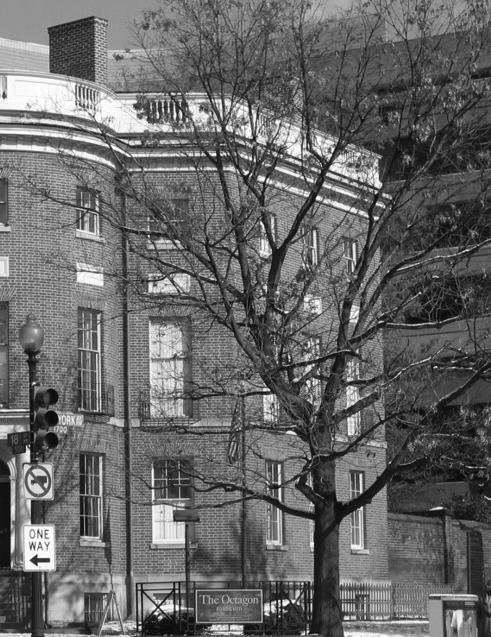
Bart Shaw
Ronald Skaggs
Mark Wellen
UTAH
RK Stewart
Roger Jackson
Jeanne Jackson
VIRGINIA
Stanford Britt
Corey Clayborne
Harold Davis
Helene Dreiling
Robert Dunay
S. Michael Evans
Lori Garrett
Walter Gilpin
H. Randolph Holmes
Robert Holzbach
David Keith
Joseph Lahendro
Mary Katherine Lanzillotta
M. Celeste Novak
Wesley Page
Donna Phaneuf
Mel Price
Jane Rathbone
Elizabeth Reader
Rob Reis
Joanna Schmickel
Robert Steele
Terri Stewart
Charles Swartz
Nicholas E. Vlattas
VERMONT
Brian Mac
WASHINGTON
Jim Hanford
L. Jane Hastings
Daniel Huberty
Douglas Ito
Mary Johnston
Lorne McConachie
Amy Miller Dowell
Burcin Moehring
J Todd Scott
James Suehiro
Scott Wolf
WISCONSIN
Lisa Kennedy
Judith Kinnard
Kenneth Schwartz
INTERNATIONAL
Sherif Anis
FIRMS & COMPANIES
CSNA Architects
Jensen Architects
Krueck Sexton Partners
MTFA Architecture PLLC
Redstone Architects, Inc
*Denotes a deceased member.


